

BUDONGO BONANZA
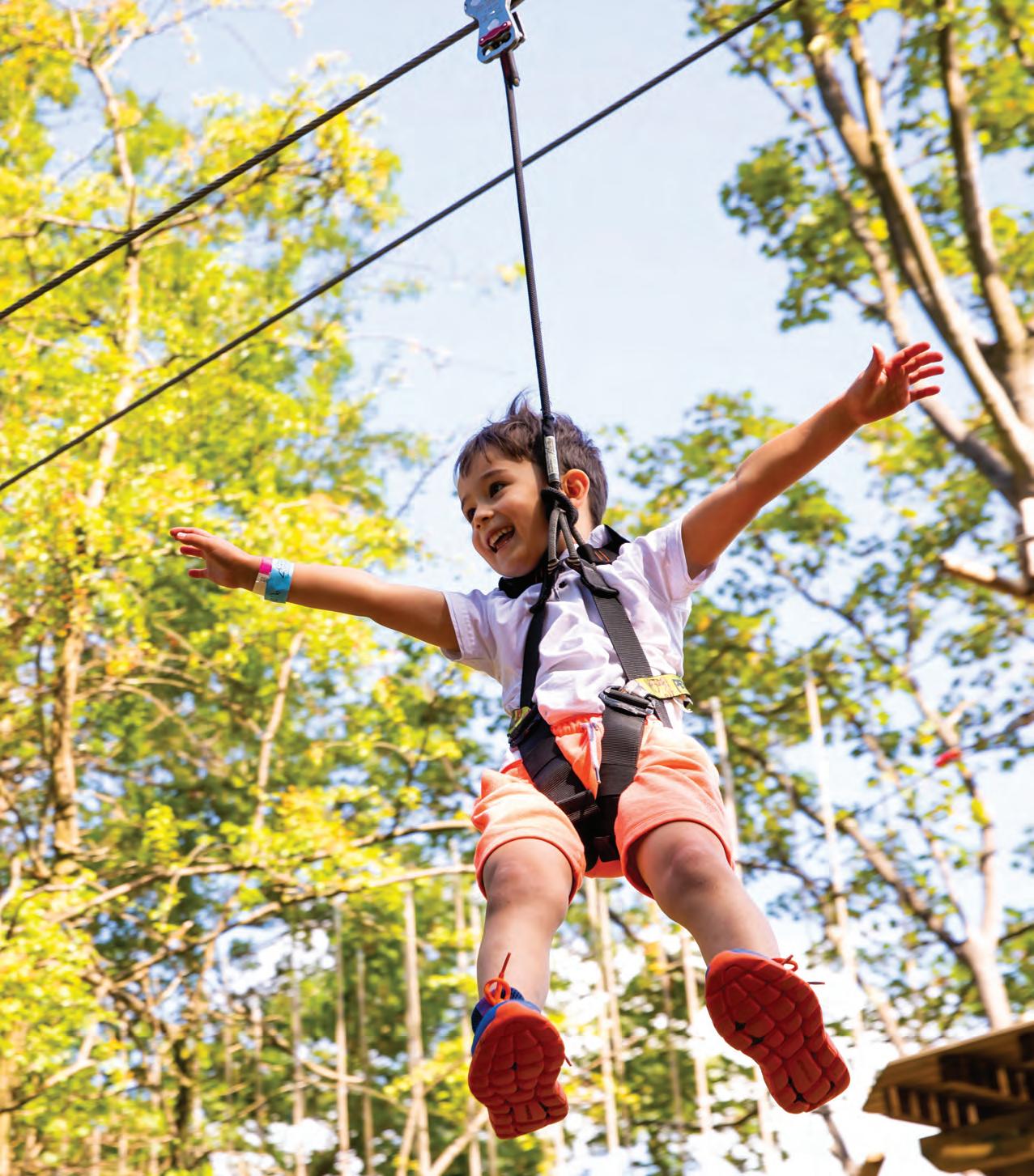

"!lZSS
THE WILDLIFE CONSERVATION CHARITY

This is the official publication for members of the Royal Zoological Society of Scotland (RZSS),the wildlife conservation charity (Scottish registered charity SC004064)
Your membership magazine and its envelope are made using paper from sustainably managed forests and are recyclable. For more information about RZSS,including details of our patrons. board and staff, visit rzss.org.uk
All content in this magazine is ©RZSS unless stated otherwise.
For any editorial enquiries, please write to Membership, RZSS, 134 Corstorphine Road, Edinburgh EH12 6TS
Or email us at: membership@rzss.org.uk
, CARBON BALANCED PAPER
w-.carbonbalancedpaper.com
CBP01693O
RZSSEditorial Team
Rhiordan Langan-Fortune, Rebecca Milne, Laura Moore, Christine Moorhouse, Lisa Robshaw, Hollie Watson
Editors Ciaran Sneddon and Emily Radway
Contributing Editor Jonathan McIntosh
Art Director George Walker
Photographers Laurie Campbell and the RZSScommunications and marketing teams
Managing Editor Andrew Littlefield
Production Director Justin Masters
Executive Director John Innes
Commercial Partnerships Manager Alison Fraser d: 0141 946 8708 e: alison.fraser@thinkpublishing.co.uk
Published by T H I N K w: www.thinkpublishing.co.uk
CONTRIBUTORS
Writer Laura Brown enjoyed getting to know Highland Wildlife Park's wonderfully wily wolverines and learning all about Tina's daily routine.
At last, summer is here. It's one of my favourite times of the year at the Royal Zoological Society of Scotland, and not just because of the better weather. During the summer, whenever I take a stroll through Edinburgh Zoo or Highland Wildlife Park, I get to see so many of you having an unforgettable day out with your friends or family. There is so much going on during the school holidays, and the lovely long days give plenty of time for exploration and discovery. Many of our animals love to bask in the glow of a warm, sunny day, too.
I'm sure it won't take much encouragement to visit our newest trioRodney, Cali and Luna -at Edinburgh Zoo. If you haven't already been caught up by capybara fever, a few minutes in the company of these chilled chums will certainly do the trick. You'll also be able to meet our sloth bears, who will arrive this summer. And I should also remind you that Haggis our pygmy hippo calf will be enjoying her first summer this year. She's growing in confidence (and size) by the day.
Contributing editor
Jonathan McIntosh
is a big fan of Rodney, Luna and Cali our new capybaras at Edinburgh Zoo as well as Highland Wildlife Park's many cats.
Up at Highland Wildlife Park, meanwhile, we've been watching the rescued lynx settle into their new home. You may have read in the news about how they were abandoned. The lynx spent some time at Edinburgh Zoo before moving north, where their bright personalities are on full show. Indeed, there are lots of new feline friends at Highland Wildlife Park: Pari, our snow leopard, and Fian, our wildcat, are also making themselves comfortable. Skipping into autumn, we're delighted to be bringing the Giant Lanterns event back to Edinburgh Zoo for the first time in six years. From November until February,you'll be transported beneath the waves as over 600 aquatic-themed lanterns shine a light on jellyfish, dolphins, turtles and maybe a few legendary creatures, too.
Discounted early bird tickets are on sale now with members getting their own discount on top!
VDav;a F;eld, VP Chief Executive Officer
Specialist gardening journalist Aileen Scoular has been finding out about edible plants, the wonders of willow and what the gardening team in the Highlands have been up to.
Make the most of your visits to our zoos this summer
Download the new Edinburgh Zoo app
Easily navigate to all your favourite animals with the Edinburgh Zoo app. Whether you want to find the best spot for a bite to eat or need to know what talks are on each day, the new app has all the information you need for an un-fur-gettable day out.
Look out for the Highland Wildlife Park app coming soon!
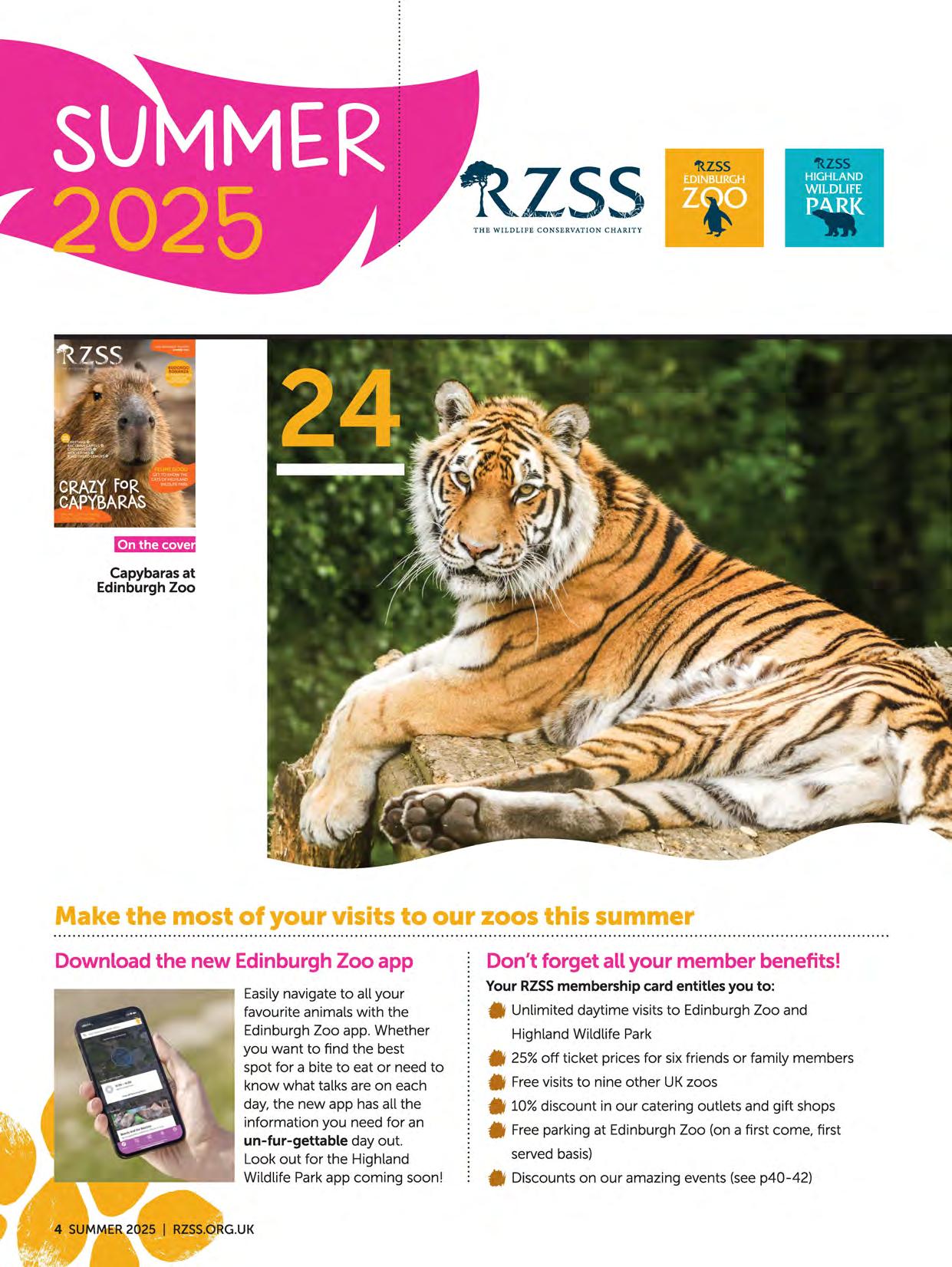
Don't forget all your member benefits!
Your RZSS membership card entitles you to:
• Unlimited daytime visits to Edinburgh Zoo and Highland Wildlife Park
• 25% off ticket prices for six friends or family members
• Free visits to nine other UK zoos
• 10% discount in our catering outlets and gift shops
• Free parking at Edinburgh Zoo (on a first come, first served basis)
• Discounts on our amazing events (see p40-42)
Capybaras at Edinburgh Zoo
THE WILDLIFE CONSERVATION CHARITY

at Edinburgh Zoo and Highland Wildlife Park
1 Non-stop smiles
We asked our team for the animals that always make them smile. Highland Wildlife Park discovery and learning programme manager Jess chose the Arctic foxes. She said, "They are always up to something and have cheeky expressions on their faces!" At Edinburgh Zoo, discovery ranger Jamie said, ·sun bear Babu is always fun, rolling around with toys or hanging off the climbing frame." Make sure to see them both on your next visits.

2 Fact find at our daily talks and shows
Join us at one of our daily keeperled talks to discover amazing animal facts and behind-the-scenes stories about how we look after your favourite animals. And if you're heading to Edinburgh Zoo this summer, enjoy a member discount on one of our Sunrise Safari Tours.
4 Immerse yourself
Travel to the Rwandan mountains and meet a family of mountain gorillas with our brand-new virtual reality experience at Edinburgh Zoo. Located within Budongo Trail, our six virtual reality pods provide a one-of-a-kind 360° experience that you won't soon forget.
5 I spy with my little eye ... Look out for some new faces on your upcoming visits. We recently welcomed new female snow leopard Pari to Highland Wildlife Park [see p13]. Plus, sloth bears are coming to Edinburgh Zoo this summer.
Book a Reserve To
Discover a new favourite animal on a Reserve Tour at Highland Wildlife Park. Led by our discovery rangers, you'll see a range of residents, including last year's Eurasian elk calf twins, and hear extraordinary stories about the park. Reserve tours must be booked online in advance at highlandwildlifepark. org.uk/reserve-tours
7
Say hello to our social media star
Last autumn, we welcomed Haggis, the tiny pygmy hippo calf, at Edinburgh Zoo. Born to parents Otto and Gloria, Haggis has since become a social media sensation and a favourite with many visitors. Book our brand-new Pygmy Hippo and Friends Magic Moment experience for the chance to get closer than ever to dad Otto, with time given to feeding him and meeting the hippos' neighbours.
8 Reduce plastic waste on your next visit
Be part of our mission to crush plastic bottle consumption by using our new 'Big Ape' water refill machine, in partnership with anti-plastic water company ape2o. The Big Ape is at the main entrance to Edinburgh Zoo, so bring your refillable bottle or purchase one of ape2o's stainless steel bottles. We're delighted that 20% of all sales will go towards RZSSconservation work.
If you are planning a visit _____ _.to the zoo with your young ones, book one of our three-hour Summer Explorer sessions for the perfect introduction to the fascinating world of nature at Edinburgh Zoo. You'll have the chance to visit our animals, play games and more. Members receive a 10% discount.

Select a souvenir
Before you go, be sure to stop by one of our Edinburgh Zoo or Highland Wildlife Park gift shops to find a memento of your visit. There's a great selection of different animal-themed gifts, from cuddly toys to games, guidebooks, homeware and more. As a member, you can enjoy a 10% discount on anything bought from our gift shops or our online store.
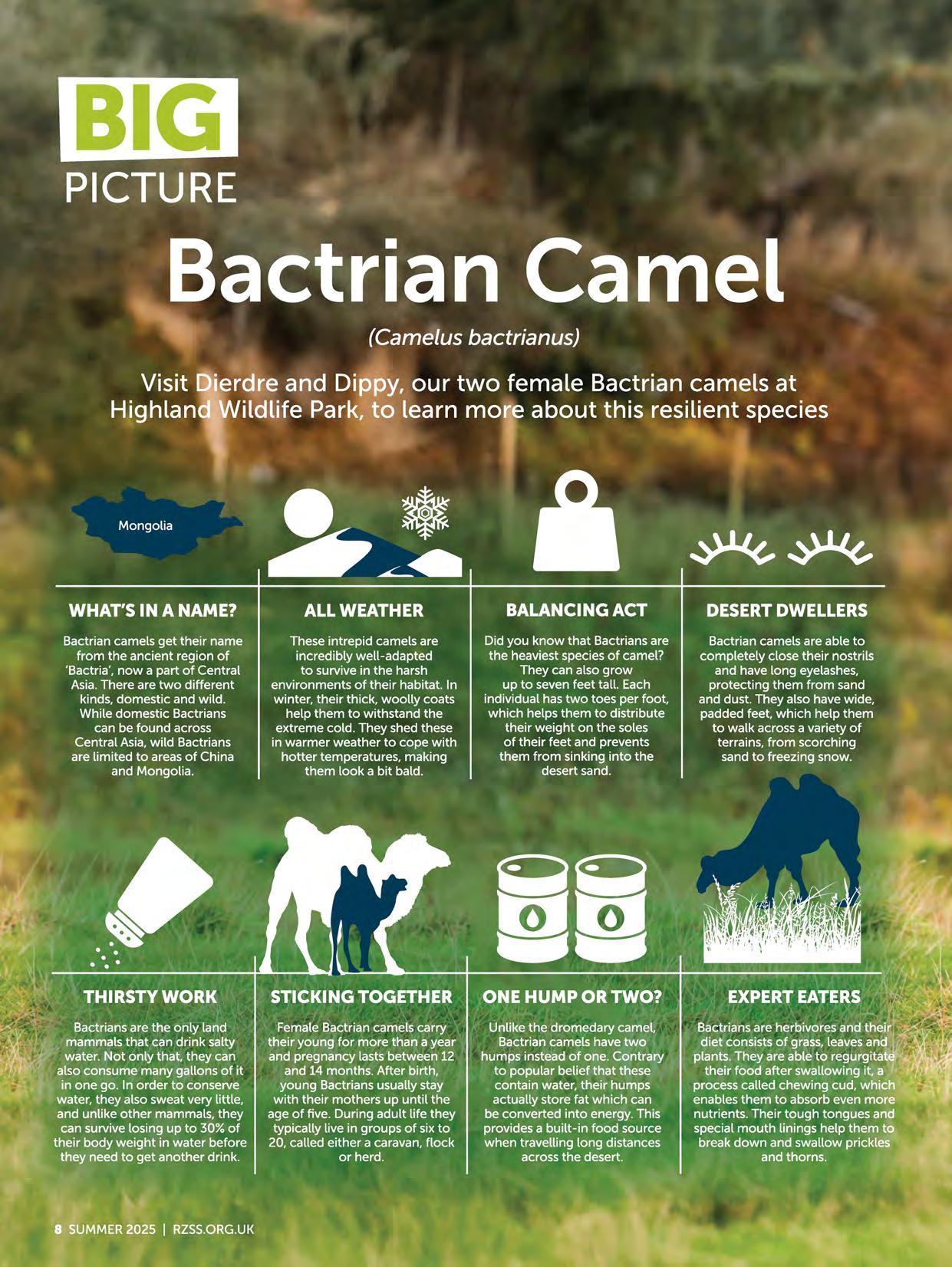
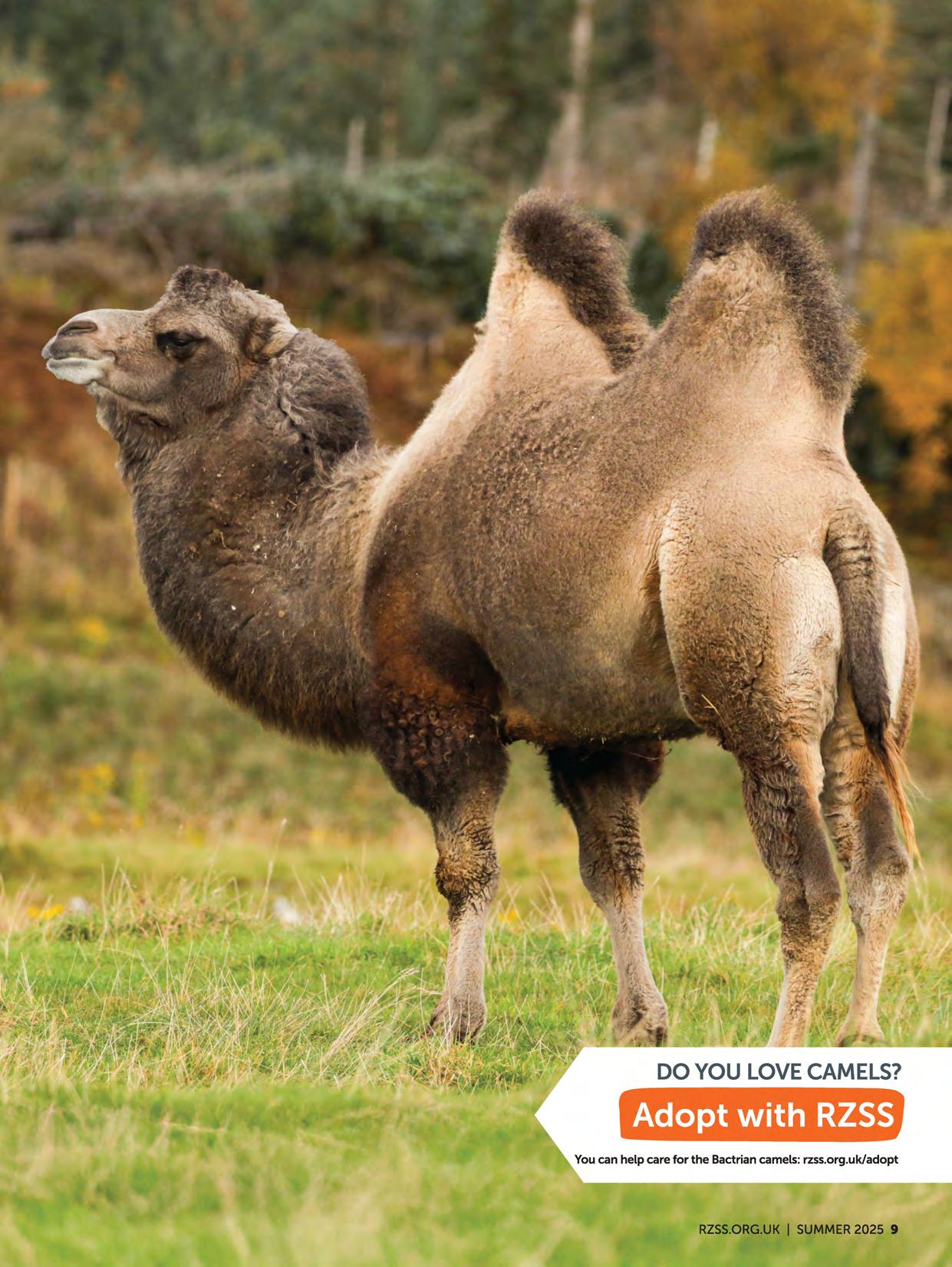


We"veloved getting to know Billy, our new cheetah, ever since he arrived in March. Billy previously lived at Whipsnade Zoo in Bedfordshire but he's now made himself at home in Edinburgh.
We're hoping to welcome a female cheetah in the future, so keep an eye out for the next issue of this magazine and your RZSSemails. This summer, make sure to head to Billy's area,just down the hill from Penguins Rock.
EDINBURGH NEWS
GENTOO PENGUIN CHICKS BEGIN TO HATCH
This year's raft of gentoo penguin chicks have been hatching at Edinburgh Zoo, with the first arriving in late April. Parents Muffin and Mittens welcomed the inaugural chick -having had the first hatchling in previous years too -before others soon followed.
Gentoo penguin parents usually stick together and mate with each other every year, before taking it in turns to incubate their eggs for between 34 and 37 days. When they hatch, the chicks weigh just 98g, roughly the same as half an avocado, and rely on their parents to care for them.
You can find the young penguins at Penguins Rock, the largest outdoor penguin pool in Europe.

We aim to transform the museum into a vibrant cultural destination for Midlothian, sharing powerful stories, platforming major events and hosting innovative green energy and wellbeing projects.
Meet our new snow leopard -and see how we celebrated Koshi's birthday
We have been delighted to welcome Pari, a young female snow leopard, to Highland Wildlife Park. Pari is almost two years old and came to the park from Wilhelma Zoo in Stuttgart, Germany.
We're hoping that Pari will help to produce a future generation of a species whose population is decreasing in the wild and is classed as Threatened on the IUCN Red List. In time, we'll be introducing her to Koshi, our resident male, but for now, Pari has just been getting used to her new home. S e was a bit shy at first, but has grown in confidence.
Around the same time as Pari's arrival, Koshi celebrated his sixth birthday. Keepers treated him to a special gift that had his portrait drawn on the front.
In May, we very sadly said goodbye to Victoria, the UK's oldest polar bear. A resident at Highland WildUfe Pa ince 2015, Victoria had been experiencing age-related health problems and received geriatric care prior to her passing. -----iBi:o:::rn at Rostock Zoo in Germany some 28 years ago in December 1996, Victoria had three cubs in total, including two boys, Hamish and Brodie, after she moved to Highland Wildlife Park.
Victoria enjoyed a long and happy life. She will be very sadly missed by all of us at Highland Wildlife Park.

As part of our busy summer events programme, we've launched a new club for young scientists, creatives and explorers. The Summer Club will run each day from Monday 28 July until Friday 1 August, with different themes that cover everything from wildlife to science, drama and games.
The club is aimed at those aged 7-11 and in addition to our planned activities, participants will also be able to explore the park, learn all about our animals and enjoy everything the site has to offer.
You can find out more about the Summer Club and all of our events online, or on p40-42 of this magazine. Our regular experiences, such as the Reserve Tours that run on Thursdays, Fridays, Saturdays and Sundays, will also be available over the summer. They can be booked online ahead of your visit.
DARK BORDERED BEAUTY MOTH
CAIRNGORMS NATIONAL
PARK
In April we hit an exciting new stage in our ongoing project to support dark bordered beauty moths. Working with partner organisations on the Rare Invertebrates in the Cairngorms (RIC) project we began a four-month initiative which involved releasing 400 eggs into a specially selected area of the national park for the very first time. The team will return in July to see how many adult moths have hatched and survived. With the species now only found at two sites in Scotland and one in England, our conservation programme, which began in 2022, is designed to mitigate against the effects of habitat loss.
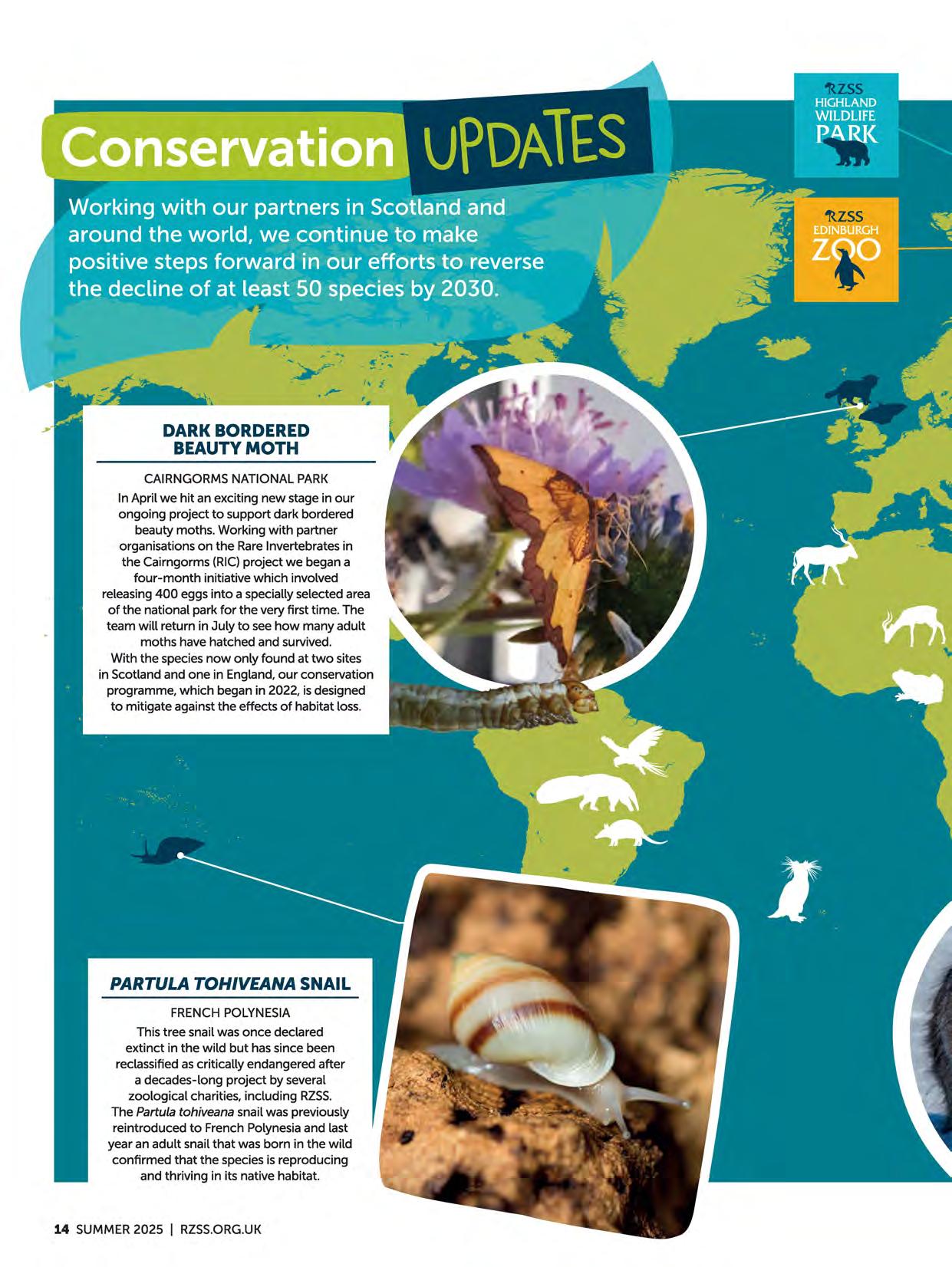
PARTULA TOHIVEANA SNAIL
FRENCH POLYNESIA
This tree snail was once declared extinct in the wild but has since been reclassified as critically endangered after a decades-long project by several zoological charities, including RZSS. The Partula tohiveana snail was previously reintroduced to French Polynesia and last year an adult snail that was born in the wild confirmed that the species is reproducing and thriving in its native habitat.
SCOTTISH WILDCAT
SCOTLAND
Clinging by a Claw, a film by Saving Wildcats, will be touring Scotland's big screens later this year. Produced by SCOTLAND: The Big Picture, this featurelength film follows Scotland's wildcats from the brink of extinction to the first ever successful releases into the iconic landscapes of the Cairngorms National Park. Join the Saving Wildcats mailing list to be the first to hear about the launch: savingwildcats.org.uk/join-us

ASIAN ELEPHANT
CAMBODIA
A new study, supported by RZSS,has produced the first robust estimate of how many Asian elephants live in Cambodia's northern plains. The habitat, formed of lowland evergreen and semi-evergreen forest, is a vital living space for the large mammals. It's hoped this new estimate will better help conservationists on the ground to protect these elephants. The figure was based on genetic sampling by Fauna and Flora, with research performed at the Royal University of Phnom Penh with support from RZSSWildGenes. It was found that 51 elephants currently call the area home.
PALLAS'S CAT
INDIA
We've launched two new projects in India as part of our work to protect and breed Pallas's cats. For 17 years, RZSS has managed a breeding programme for the cats, during which time we also set up the Pallas's Cat International Conservation Alliance (PICA), alongside Nordens Ark and the Snow Leopard Trust. This project has combined research with strategic planning, awareness-raising and international collaboration. In the last five years, we've supported 18 projects through PICA's Small Grant Programme (SGP).This work wouldn't be possible without the continued support of zoos around the world, with 18 collections having supported PICA and the SGP.
Where to see them: Edinburgh Zoo
Budongo Trait's 13-strong troop of chimpanzees certainly have healthy appetites. But spending your days swinging and playing around is thirsty work too. That's why our chimps enjoy guzzling down lots of sugar-free diluting juice to stay hydrated. And if the temperatures are especially \ sweltering, we'll give them ice lollies to stay nice and cool in the summer heat.

Where to see them: Edinburgh Zoo
In the wild, these winged wonders can be seen soaring through the lowland forests of Singapore, Malaysia, Indonesia and Thailand. Figs and durian are favourites of these frugivores, who are known to feed and thrive on over 50 different species of fruit. Insects and mice are also on their menu. Our hornbill Kato, who you can see as part of Animal Antics, gets excited for eggs.
Where to see them:
Edinburgh Zoo
When it comes to laid back living, you'd be hard pressed to find an animal who does it better than the sloth. Given that Edinburgh Zoo sloths Nico and Feira like spending up to 15 hours a day sleeping, they certainly live up to this stereotype. Our two sloths will pick up the pace for flowers, though, such as camellias, forsythia and silver wattle.
Where to see them:
Highland Wildlife Park
Native to the forests of Scandinavia and Russia, these herbivores use their incredible senses of smell and sight to search for their most loved of all nibbles: lichen. Did you know over 1,500 lichen species grow in Scotland? This is great news for our reindeer quartet -Sven, Freya and their daughters Lumi and Kesawho are lucky enough to enjoy the many types in their habitat.
Where to see them:
Highland Wildlife Park
These carnivores hunt deer and boar in the wild. The taste buds of our wolf pack, comprising Storr, Beinn, Chonzie and Merrick, are a little different. When this quartet of howling wolves are ready to chow down on something tasty, you'll find them in Wolf Wood enjoying a feast of meat or fish. In the summer, they also enjoy ice-block concoctions made from blood and either berries or vegetables.

Edinburgh Zoo
As their name suggests, Zeferino and Gizmo's choicest dishes are ants, termites and other bugs and beasties. But these interesting insectivores, found throughout South and Central America, also enjoy a lactose-free yoghurt. Look out for them gobbling it up for elevenses or as a post-lunch snack.
Edinburgh Zoo
These prickly quilled creatures are the largest porcupine in the world. They are known to polish off fruit and drag bark and bones back to their dens throughout Central and Southern Africa to dig in to. For Rick and Zahara, nothing beats sweetcorn, which they enjoy crunching away on.
Edinburgh Zoo
Leaves, bark, insects, fruits, sap and even soil are scarfed up by these Madagascan dwellers. Their long, banded tails help them balance when foraging for food up in trees. But what makes their mouths water? Flowers, lentils and peas are Kitata, Jingoma, Tipiaka and Pop Pop's top scran.


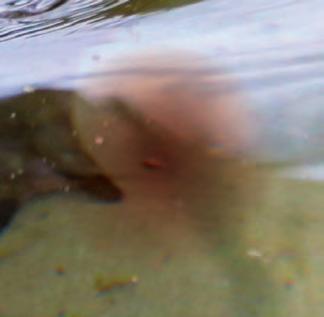
ppearing like a cross between a supersized guinea pig and a beaver, capybaras are as curiouslooking as they are cute.
And thanks to memes, videos and even a theme song dedicated to them, these laidback South American natives have taken the internet by storm over the past few years and won the hearts of millions in the process.
But what is it about these gentle giants that has us so transfixed? According to senior hoofstock keeper Jade Robertson, the best way to find out is to take a summertime trip to Edinburgh Zoo to see what makes our new capybara trio -comprising Luna, Cali and latest arrival Rodney -tick.
"Our half-sisters Luna and Cali arrived at Edinburgh Zoo from Jimmy's Farm & WildlifePark in February, while Rodney arrived from Dartmoor Zoo shortly after in April,"says Jade. "I've been helping settle them in ever since."
Measuring up to 134cm in length and reaching up to 70kg, these hefty

herbivores are extremely sociable and can live in herds numbering 10-40 members. Over the past few months, Jade and team have been hard at work cultivating a similar camaraderie between Luna, Cali and Rodney, who are all around one year old.
Getting things ready
"When we found out we were getting a mixed group, we split the enclosure into two and set up a pool schedule to give Rodney access when Luna and Cali weren't going for a dunk. This allowed all three to get accustomed to one another -with the separating mesh fence providing plenty of opportunities for inquisitive sniffs, calls and flirting," explains Jade.
"Originally,we'd planned to keep Luna, Cali and Rodney separate for just a few days, but because Cali's not breeding this year we took introductions slower than usual," says Jade. "We started leaving them in the enclosure together in May and separated them overnight to be safe as Rodney's bigger than the girls. Thankfully though, they were content in each other's company quickly."
The world's largest rodent communicates via a variety of sounds from barking and teeth chattering (signalling danger and anger), purring (a happy vibration) to whistling and clicking (romantic tactics designed to 0
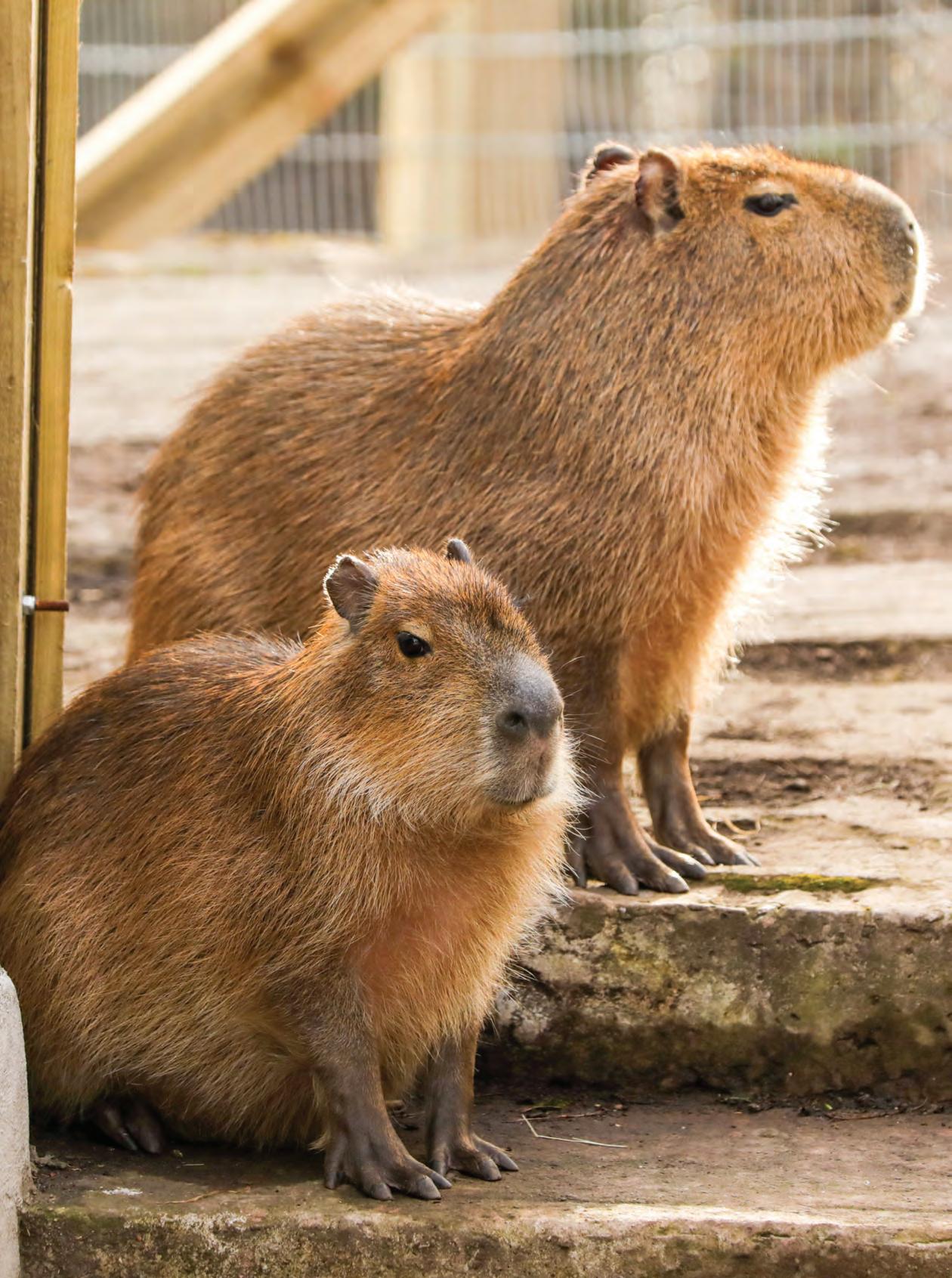
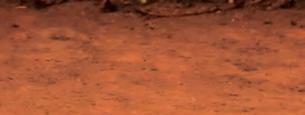
woo any would-be mates}. Luna, Cali and Rodney's personalities are as distinct as their calls.
"Luna and Cali were nervous when they first arrived but now they're really confident and enjoy following us around the enclosure -especially if there's food about! Luna is the more adventurous of the two. She's a daredevil who gets a thrill from jumping into the pool and seeing what what mischief she can cause. Rodney's a bit shyer in comparison," says Jade.
"When it comes to food, the girls and Rodney have distinct tastes. Unusually for capybaras, Luna and Cali love beetroot. It turns their lips purple and they end up looking like wee monsters! Rodney prefers munching peppers and sweet potatoes."
All about capybaras
The scientific name for capybaras is Hydrochoerus hydrochaeris. They're also sometimes referred to as 'water pigs' -a fitting moniker seeing as these creatures love spending their days in and around water.
Capybaras' bodies are perfectly adapted to the life semi-aquatic.
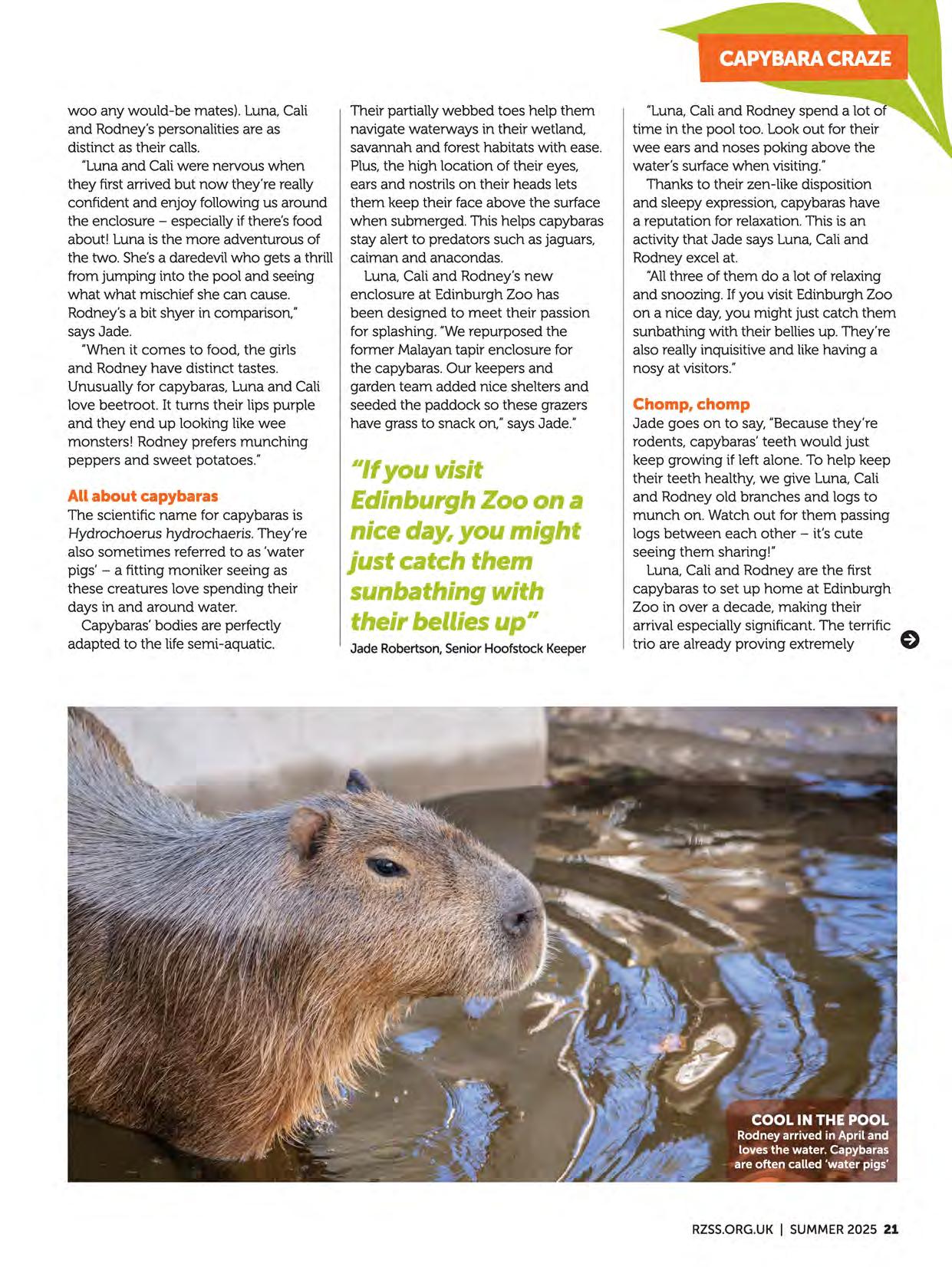
Their partially webbed toes help them navigate waterways in their wetland, savannah and forest habitats with ease. Plus, the high location of their eyes, ears and nostrils on their heads lets them keep their face above the surface when submerged. This helps capybaras stay alert to predators such as jaguars, caiman and anacondas.
Luna, Cali and Rodney's new enclosure at Edinburgh Zoo has been designed to meet their passion for splashing. "Werepurposed the former Malayan tapir enclosure for the capybaras. Our keepers and garden team added nice shelters and seeded the paddock so these grazers have grass to snack on," says Jade."
11
/f you visit Edinburgh Zoo on a nice day, you might just catch them sunbathing with their bellies up"
Jade Robertson,SeniorHoofstockKeeper
"Luna, Cali and Rodney spend a lot o time in the pool too. Look out for their wee ears and noses poking above the water's surface when visiting."
Thanks to their zen-like disposition and sleepy expression, capybaras have a reputation for relaxation. This is an activity that Jade says Luna, Cali and Rodney excel at.
"Allthree of them do a lot of relaxing and snoozing. If you visit Edinburgh Zoo on a nice day, you might just catch them sunbathing with their bellies up. They're also really inquisitive and like having a nosy at visitors."
Chomp, chomp
Jade goes on to say, "Because they're rodents, capybaras' teeth would just keep growing if left alone. To help keep their teeth healthy, we give Luna, Cali and Rodney old branches and logs to munch on. Watch out for them passing logs between each other - it's cute seeing them sharing!"
Luna, Cali and Rodney are the first capybaras to set up home at Edinburgh Zoo in over a decade, making their arrival especially significant. The terrific A trio are already proving extremely W
popular with visitors. And for Jade, it's easy to see why.
"Capybaras are so chilled but extremely characterful. I love the sassiness of their side eye, but their deadpan expression is also hilarious," laughs Jade. "Luna, Cali and Rodney have such quirky temperaments, which makes them so endearing. They always put a smile on my face and are so interesting to watch."
The successful introduction of Luna, Cali and Rodney marks an exciting new chapter in Edinburgh Zoo's capybara story. Jade and the team hope that Luna and Rodney go on to have pupsaffectionately dubbed babybarasof their own in the future.
Zoo ambassadors
Now that they're comfortably in their new home at Edinburgh Zoo, Luna, Cali and Rodney are taking on an important role in helping with our mission to protect, value and love nature.
As Jade says, "Luna, Cali and Rodney's enclosure is always popular. Lately all I've seen is young visitors with stuffed capybara
toys! It's great to see because when people come to the zoo to watch them they don't only fall in love with these capybaras, they become more invested in nature.
"Luna, Cali and Rodney are great ambassadors for RZSS.They raise awareness and funds to support our conservation efforts and empower visitors to care about animals. It's an incredible feat for such an easy-going

rzss.org.uk/adopt


We're a nation of cat lovers. And given their cuteness, charm, aloofness and affection (usually doled out to owners on their own terms), it's hardly surprising that cats are consistently ranked the UK'sfavourite pets after dogs. While domesticated moggies have us enamoured, what about their wild counterparts?
Showing the same kind of curiosity that these furry creatures are famous for, we spoke to carnivore keeper Abbey Weaver to find out what makes Highland Wildlife Park's felines the cat's pyjamas.
"I've been a carnivore keeper at Highland Wildlife Park for two and a half years -first working with the wildcats before helping to care for the snow leopards, Eurasian lynx and Amur tigers," says Abbey.
"I love everything about the role. Whether making up feeds or training these animals, it's rewarding
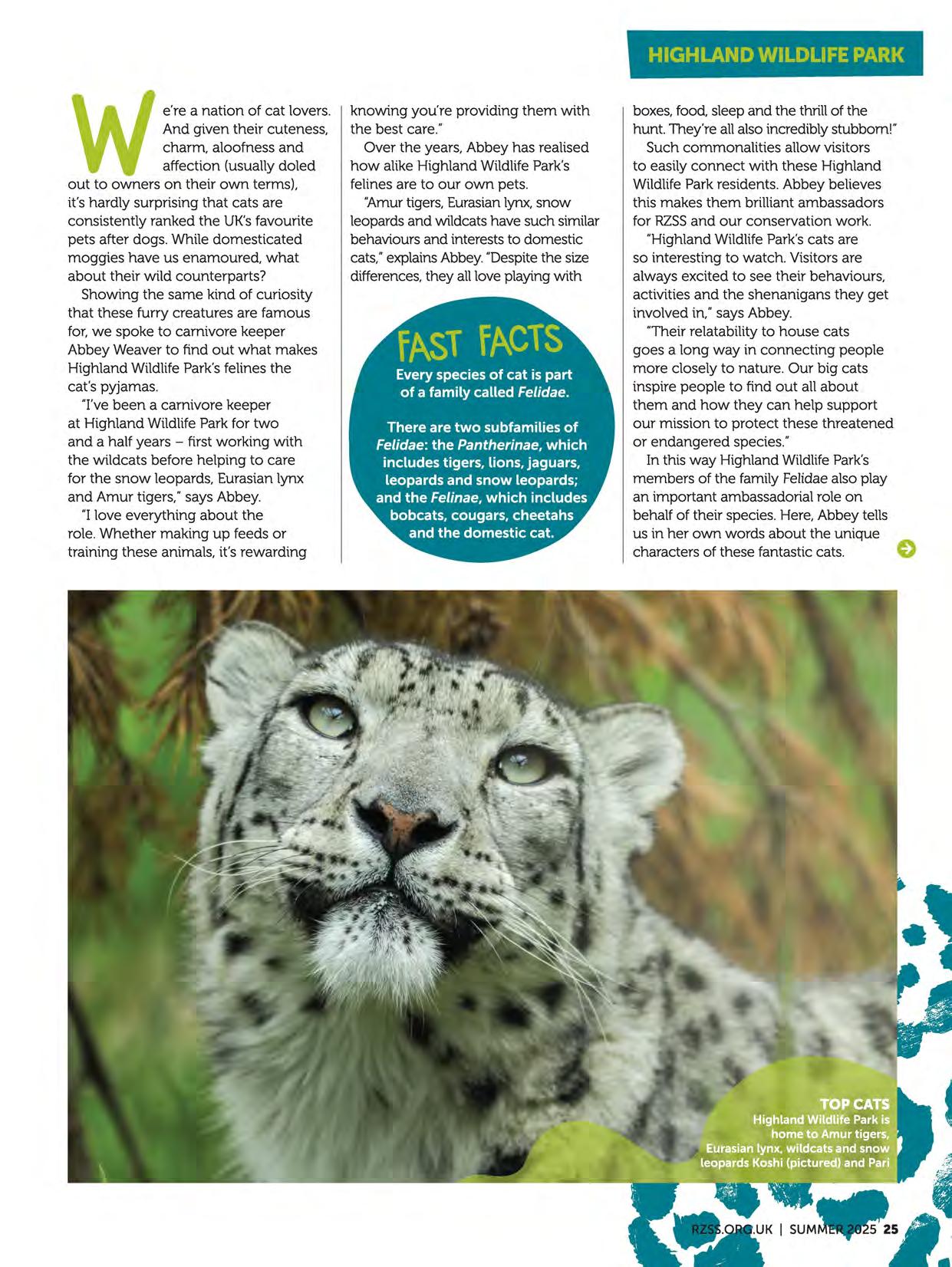
knowing you're providing them with the best care."
Over the years, Abbey has realised how alike Highland Wildlife Park's felines are to our own pets.
"Amurtigers, Eurasian lynx, snow leopards and wildcats have such similar behaviours and interests to domestic cats," explains Abbey. "Despite the size differences, they all love playing with
boxes, food, sleep and the thrill of the hunt. They're all also incredibly stubborn!"
Such commonalities allow visitors to easily connect with these Highland Wildlife Park residents. Abbey believes this makes them brilliant ambassadors for RZSSand our conservation work.
"Highland Wildlife Park's cats are so interesting to watch. Visitors are always excited to see their behaviours, activities and the shenanigans they get involved in," says Abbey.
"Their relatability to house cats goes a long way in connecting people more closely to nature. Our big cats inspire people to find out all about them and how they can help support our mission to protect these threatened or endangered species."
In this way Highland WildlifePark's members of the family Felidae also play an important ambassadorial role on behalf of their species. Here, Abbey tells us in her own words about the unique characters of these fantastic cats.
AMUR TIGER
(Panthera tigris altaica)
Family affair
Dominika, 16, is our oldest and was born here. Botzman, 14, was born in Moscow, Russia, but came to us from Whipsnade Zoo in 2020.
The pair welcomed three cubs in May 2021: Layla, Nishka and Aleksander. Aleksander moved to Tallinn Zoo, in Estonia, in July 2024 to join the Amur tiger European Endangered Species Programme.
Layla and Nishka are similar in size, but their coats distinguish them: Layla's is light while Nishka's is dark. We're currently training them to get used to crates, which they'll travel in when moving to other zoos to join the breeding programme.
Dominika and Botzman are amazing parents. Layla and Nishka have some sibling rivalry, but that's natural. Layla is a mummy's girl, while Nishka only has eyes for her dad. Botzman lives in his own enclosure, but Nishka always gets as close to him as possible.
Winning personalities
Dominika is strong-minded, loves lazing and enjoys exploring everything around her. She's fond of giving her keepers a fright, too.
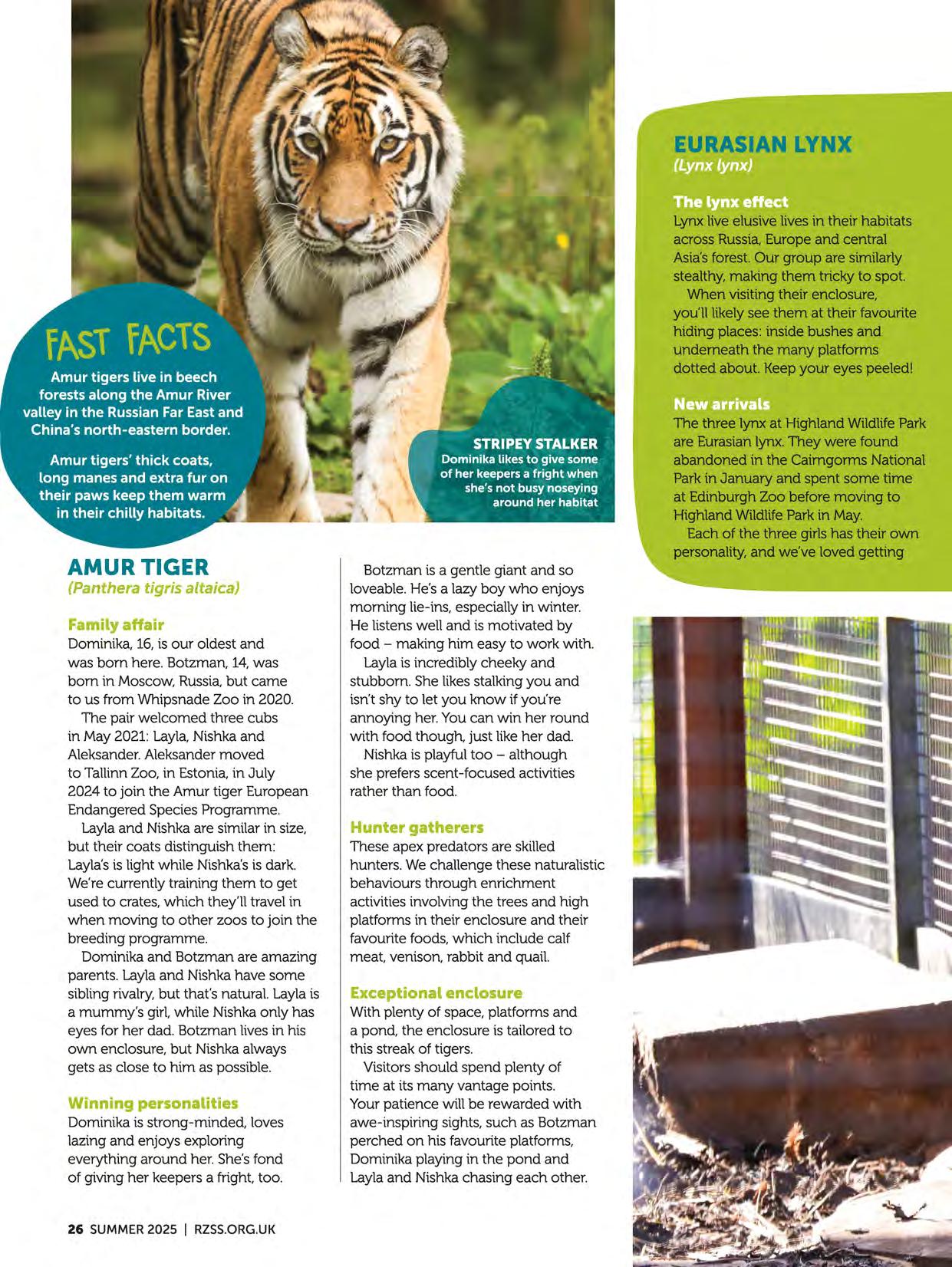
Botzman is a gentle giant and so loveable. He's a lazy boy who enjoys morning lie-ins, especially in winter. He listens well and is motivated by food -making him easy to work with.
Layla is incredibly cheeky and stubborn. She likes stalking you and isn't shy to let you know if you're annoying her. You can win her round with food though, just like her dad. Nishka is playful too -although she prefers scent-focused activities rather than food.
Hunter gatherers
These apex predators are skilled hunters. We challenge these naturalistic behaviours through enrichment activities involving the trees and high platforms in their enclosure and their favourite foods, which include calf meat, venison, rabbit and quail.
Exceptional enclosure
With plenty of space, platforms and a pond, the enclosure is tailored to this streak of tigers.
Visitors should spend plenty of time at its many vantage points. Your patience will be rewarded with awe-inspiring sights, such as Botzman perched on his favourite platforms, Dominika playing in the pond and Layla and Nishka chasing each other.
EURASIAN LYNX
Lynx live elusive lives in their habitats across Russia, Europe and central Asia's forest. Our group are similarly stealthy, making them tricky to spot. When visiting their enclosure, you'll likely see them at their favourite hiding places: inside bushes and underneath the many platforms dotted about. Keep your eyes peeled!
The three lynx at Highland WildlifePark are Eurasian lynx. They were found abandoned in the Caimgonns National Park in January and spent some time at Edinburgh Zoo before moving to Highland WildlifePark in May. Each of the three girls has their own personality, and we've loved getting
to know them. Among their favourite activities are playing with each other, often with balls or other toys, and sniffing out their new surroundings.
As with domestic cats, these lazybones like to catch plenty of Zs. Whenever they're not interested in training or enrichment, we'll leave them to catnap.

SNOW LEOPARD
(Uncia uncia)
Awesome twosome
Koshi, five, came to us from The Big Cat Sanctuary in Ashford in December 2019. Pari, our one-year-nine-month-old female, arrived from Stuttgart's Wilhelma Zoo in May this year.
They're living separately right now, but we'll introduce them slowly over the coming months. We hope this pair will produce a future generation of this increasingly rare species one day.
Distinct characteristics
Koshi is a big people-oriented pussycat, making him purr-fectly suited to the Magic Moments visitor experiences he takes part in. He loves playing hide and seek -we pretend we can't see him and he excitedly bounds towards us. It's my favourite Koshi quirk
Given that she only arrived recently, we're getting to know Pari at her pace.
As with all of Highland WildlifePark's cats, we recommend spending plenty of time at this duo's enclosure to see their interesting behaviours.
Food fanatics
Koshi tucks in to rats, quail, venison and horse. He'll do anything for food and is more interested in enrichment activities when they're centred around snacks. He's such a lazy boy that he often wants
you to hand feed him! Pari's a bit fussier. She's not keen on rats.
Tip-top trainees
These natives of central Asia's mountains are great to work with. They pick up routines and other things quickly. Koshi is very trainable. Once we know what Pari likes, we'll win her round too.
Clever camouflagers
Snow leopards' white-greyish fur keeps them camouflaged and cosy in their frigid habitats. It can sometimes be tricky seeing our pair when they're relaxing on their rocks because they blend in so well. When visiting, have fun seeing who's first to clock these masters of disguise!
WILDCAT
(Felis silvestris)
Woodland wonders
Wander over to Wildcat Wood to see female wildcat Fian and male wildcat Rannoch. They don't live together yet but are very aware of each other. We'll be introducing them over the summer as they're going to be a breeding pair.
The other wildcats we care for are looked after away from public view in the Saving Wildcats conservation breeding for release centre -the European partnership project led by RZSSto save this species from extinction in Britain.
New acquaintances
Fian ana Rannoch are relatively new, so we're still getting to know
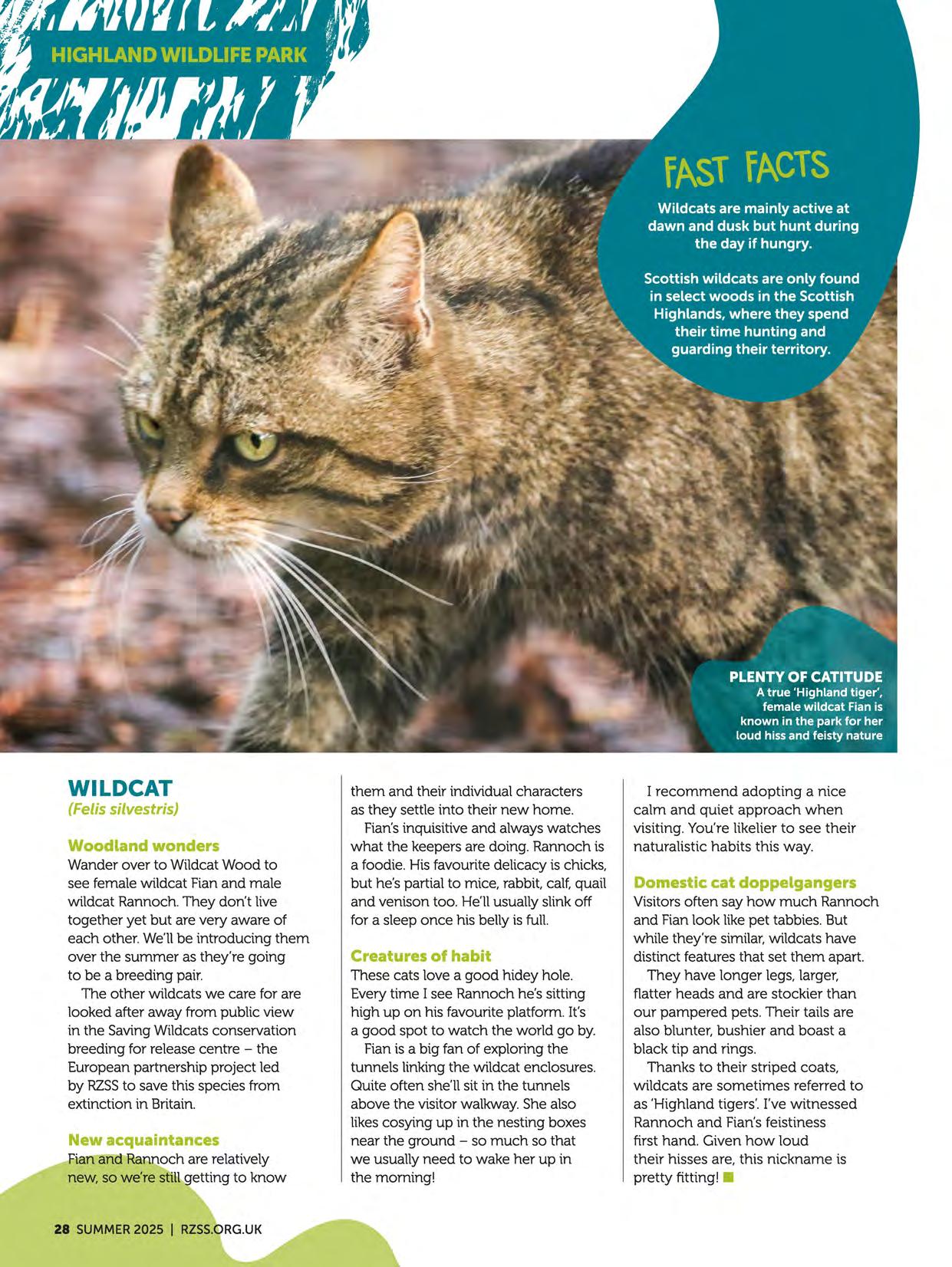
them and their individual characters as they settle into their new home.
Fian's inquisitive and always watches what the keepers are doing. Rannoch is a foodie. His favourite delicacy is chicks, but he's partial to mice, rabbit, calf, quail and venison too. He'll usually slink off for a sleep once his belly is full.
Creatures of habit
These cats love a good hidey hole. Every time I see Rannoch he's sitting high up on his favourite platform. It's a good spot to watch the world go by.
Fian is a big fan of exploring the tunnels linking the wildcat enclosures. Quite often she'll sit in the tunnels above the visitor walkway. She also likes cosying up in the nesting boxes near the ground -so much so that we usually need to wake her up in the morning!
I recommend adopting a nice calm and quiet approach when visiting. You're likelier to see their naturalistic habits this way.
Domestic
cat doppelgangers
Visitors often say how much Rannoch and Fian look like pet tabbies. But while they're similar, wildcats have distinct features that set them apart.
They have longer legs, larger, flatter heads and are stockier than our pampered pets. Their tails are also blunter, bushier and boast a black tip and rings.
Thanks to their striped coats, wildcats are sometimes referred to as 'Highland tigers'. I've witnessed Rannoch and Fian's feistiness first hand. Given how loud their hisses are, this nickname is pretty fitting!

Book in advance
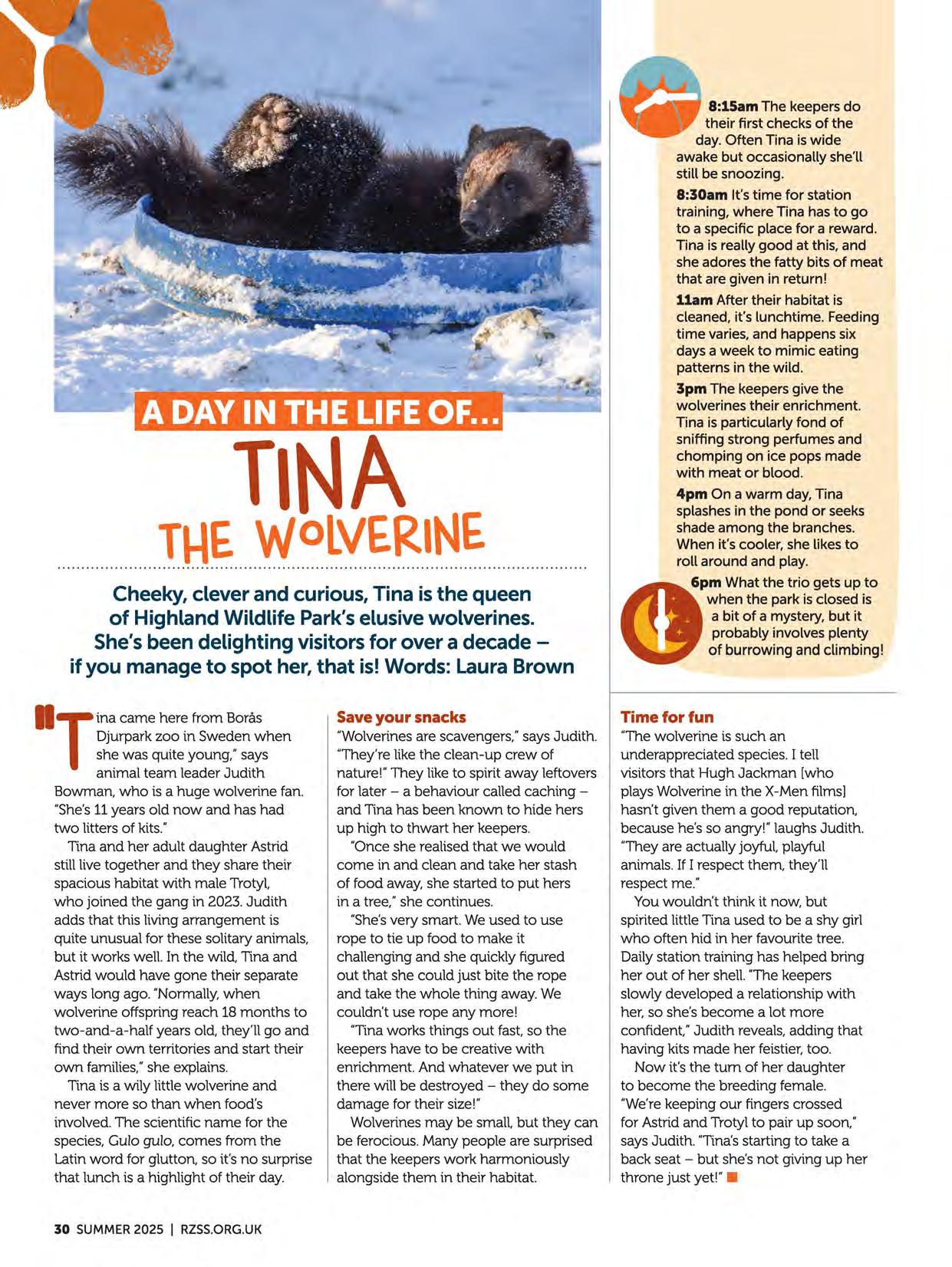
A DAY IN THE LIFEOF... TINA
Tl-IEWOLVERINE
Cheeky, clever and curious,Tina is the queen of Highland Wildlife Park'selusivewolverines. She'sbeen delighting visitorsfor over a decadeif you manage to spot her, that is!Words: Laura Brown
''Tina came here from Boras Djurpark zoo in Sweden when she was quite young," says animal team leader Judith Bowman, who is a huge wolverine fan. "She's 11 years old now and has had two litters of kits."
Tina and her adult daughter Astrid still live together and they share their spacious habitat with male Trotyl, who joined the gang in 2023. Judith adds that this living arrangement is quite unusual for these solitary animals, but it works well. In the wild, Tina and Astrid would have gone their separate ways long ago. 'Normally, when wolverine offspring reach 18 months to two-and-a-half years old, they'll go and find their own territories and start their own families," she explains.
Tina is a wily little wolverine and never more so than when food's involved. The scientific name for the species, Gulo gulo. comes from the Latin word for glutton. so it's no surprise that lunch is a highlight of their day.
Save your snacks
"Wolverines are scavengers," says Judith. "They're like the clean-up crew of nature!" They like to spirit away leftovers for later -a behaviour called cachingand Tina has been known to hide hers up high to thwart her keepers.
"Once she realised that we would come in and clean and take her stash of food away, she started to put hers in a tree," she continues.
"She'svery smart. We used to use rope to tie up food to make it challenging and she quickly figured out that she could just bite the rope and take the whole thing away. We couldn't use rope any more!
"Tina works things out fast. so the keepers have to be creative with enrichment. And whatever we put in there will be destroyed -they do some damage for their size!"
Wolverines may be small. but they can be ferocious. Many people are surprised that the keepers work harmoniously alongside them in their habitat.
8:15am The keepers do their first checks of the day. Often Tina is wide awake but occasionally she'll still be snoozing.
8:30am It's time for station training, where Tina has to go to a specific place for a reward. Tina is really good at this, and she adores the fatty bits of meat that are given in return!
11am After their habitat is cleaned, it's lunchtime. Feeding time varies, and happens six days a week to mimic eating patterns in the wild.
3pm The keepers give the wolverines their enrichment. Tina is particularly fond of sniffing strong perfumes and chomping on ice pops made with meat or blood.
4pm On a warm day, Tina splashes in the pond or seeks shade among the branches. When it's cooler, she likes to roll around and play.
6pm What the trio gets up to when the park is closed is a bit of a mystery, but it probably involves plenty of burrowing and climbing!
Time for fun
"The wolverine is such an underappreciated species. I tell visitors that Hugh Jackman [who plays Wolverine in the X-Men films] hasn't given them a good reputation. because he's so angry!" laughs Judith. "They are actually joyful, playful animals. If I respect them. they'll respect me."
You wouldn't think it now, but spirited little Tina used to be a shy girl who often hid in her favourite tree. Daily station training has helped bring her out of her shell. "The keepers slowly developed a relationship with her. so she's become a lot more confident," Judith reveals, adding that having kits made her feistier, too.
Now it's the tum of her daughter to become the breeding female. "We're keeping our fingers crossed for Astrid and Trotyl to pair up soon," says Judith. "Tina's starting to take a back seat -but she's not giving up her throne just yet!"



e're deep within the lush confines of Uganda's Budongo Forest, where towering mahogany trees pierce the sky and the sultry air throbs to the sound of the rainforest. Here lives a flagship species and a conservation project that have touched the lives of many.
Magnificently biodiverse, Budongo is home to one of the world's largest populations of chimpanzees -around 800 individuals at last count. With chimps listed as Endangered on the International
Union for Conservation of Nature's Red List,it's a vital stronghold for one of our closest cousins in the animal world.
Budongo is hugely important in terms of habitat too. Comprising 435km 2 of continuous forest cover in Uganda's western Albertine Rift,it is the largest area of tropical rainforest in East Africa.At a time when such habitat is being lost at an increasing rate globally, it is one of the few tropical rainforests that has nationally protected status in its entirety.
Studied by scientists for almost a century, Budongo is the site of the oldest tropical rainforest research plots

in the world. The forest's relationship with Scotland dates back almost as long, with the first studies of its plant life documented by Dr William Julius Eggeling, a renowned Scottish botanist, in the 1940s.
However, it was the population of chimpanzees that saw the establishment of what began as the Budongo Forest Project by Professor Vernon Reynolds some 35 years ago. Having first visited to study chimpanzees in 1962, Professor Reynolds felt compelled to act when he read reports in the late 1980s of chimpanzee infants from the forest
being captured and smuggled out of the country to wealthy pet-owners living around the world.
He returned to Uganda in 1990 and, together with local scientist Chris Bakuneeta, established a base at Budongo to discover how many chimpanzees remained in the forest. Over the ensuing years, project staff got to know the two communities of the remaining chimps and have observed them ever since. The Budongo Conservation Field Station (BCFS)was born.
Chimpanzees play an especially valuable role in the forest. During the Ugandan civil war in the 1970s and 1980s, elephants were wiped out from Budongo, leaving chimps as the largest mammals. With many of Budongo's trees dependent upon seed dispersal via digestion by large mammals, the chimpanzee's wide-ranging foraging and depositing of seeds is essential to the health of the forest -with studies demonstrating that seeds are more likely to germinate having passed through a chimp's gut.
Long-term support
While chimpanzees are the focus, an 'umbrella' species approach to conservation means that efforts to protect chimps benefit many other species in the forest. They include global rarities such as Nahan's partridge, a member of the quail family found in only a few other locations in Uganda and Democratic Republic of Congo.
Supported by RZSSsince 2005, the scope of BCFS'sactivities has

expanded significantly -from primate research and the study of birds to plant phenology and weather patterns -with a staff of more than 40 Ugandan nationals now working daily in the forest. Today, it is considered a model for how to implement practical conservation action alongside world-leading research, the training of conservation biologists and community engagement.
With some members of the team having observed Budongo's chimpanzees for over three decades, BCFSfield staff are world experts in chimpanzee ecology and behaviour. This expertise is willingly shared, with BCFS staff hosting and visiting local schools, as well as Ugandan and international conservation biologists and primatologists. Such visits have generated hundreds of scientific papers, although the team also publish their own research in an online journal, Perspectives Collective, which gives an important voice to indigenous primatologists.
From the beginning, RZSS'ssupport has been driven by a strong belief in the team on the ground, with long-term funding giving BCFSthe stability to develop its work over many years.
"RZSSfunds the employment of field staff and items such as vehicles, and also helps BCFSto leverage additional funding from elsewhere for specific projects," explains RZSSassistant conservation project officer Laura Daniels, who provides project support for the partnership from Edinburgh Zoo.
Such support often has an impact far beyond Budongo. In 2008, RZSS funded the employment of the first BCFSvet, a move which led to the development of a programme of health
11 When I visited... I was struck by how impactful it is, not just for the wildlife of the forest but also for local people and communities 11
Laura Daniels, Assistant Conservation Project Officer
monitoring and protocols that are now widely used by chimpanzee projects throughout the country.
Forest people
Recognising that successful nature conservation is as much about people as wildlife,local community outreach has

long been at the heart of BCFS'swork. "When I visited Budongo for the first time, I was struck by how impactful it is not just for the wildlife of the forest but also for local people and communities," says Laura.
With the majority of its staff coming from small villages close to the forest, BCFShelps improve the welfare of what are often low-income communities. The offer of stable, longterm employment can be transformative. "Mychildren are educated because of the work I am doing here in the forest following the chimps," remarks KizzaVincent, a field assistant who has worked with BCFSsince 2014.
Community outreach has also involved influencing behaviours. The local villagers -predominantly low-income farmers who cook meals over an open fire -have long utilised the forest's resources with that, historically, spilling over into illegal uses such as logging and charcoal burning. But now the daily presence of BCFS staff in the forest discourages such activities with the result that, unlike other areas where logging has taken its toll, it's still possible to see mature mahogany trees, some more than 80m tall. These ancient trees offer a vertical habitat for many species and also contribute to the rainforest's ability to absorb and store carbon.
11Some of the lessons from BCFS1s work have been incorporated into RZSS-led species recovery
projects in Scotland 11
LauraDaniels, AssistantConservationProjectOfficer
Meanwhile, BCFSstaff have run projects where they train and provide the resources for local people to grow their own woodlots. "These are small parcels of quick-growing trees that villagers can use for fuel instead of wood from the rainforest," notes Laura.
Poaching too has been a major problem, with hunters using snares to catch wild animals for food or trade. While chimps are not necessarily a target species, many become caughtespecially inquisitive juveniles. Around a third of all Budongo's chimps have a snare injury, with missing fingers and limbs common.
In 2002, BCFSestablished a snare removal team that patrols the forest daily, removing thousands of snares
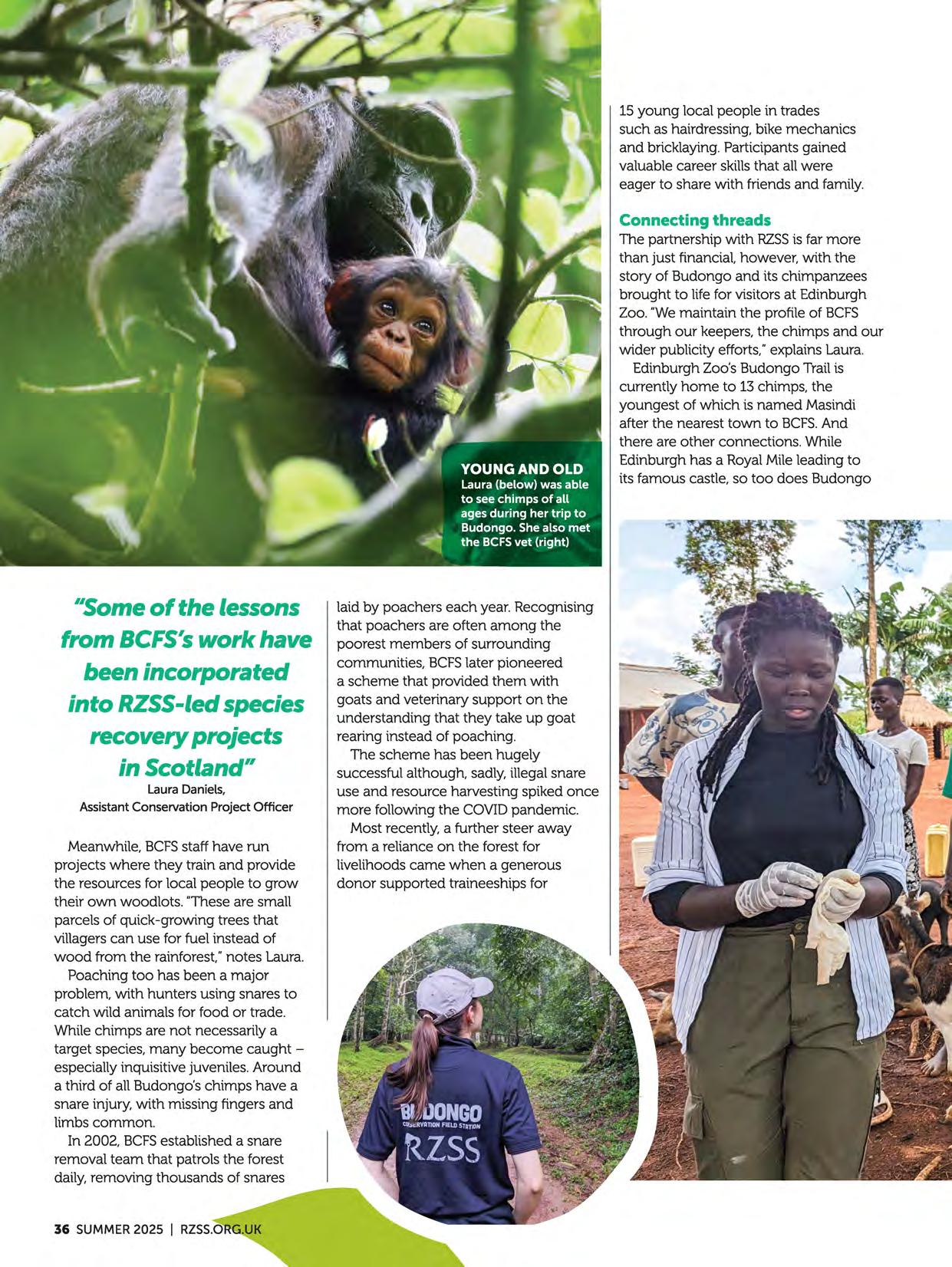
laid by poachers each year. Recognising that poachers are often among the poorest members of surrounding communities, BCFSlater pioneered a scheme that provided them with goats and veterinary support on the understanding that they take up goat rearing instead of poaching.
The scheme has been hugely successful although, sadly, illegal snare use and resource harvesting spiked once more following the COVIDpandemic.
Most recently, a further steer away from a reliance on the forest for livelihoods came when a generous donor supported traineeships for
15 young local people in trades such as hairdressing, bike mechanics and bricklaying. Participants gained valuable career skills that all were eager to share with friends and family.
Connecting threads
The partnership with RZSSis far more than just financial, however, with the story of Budongo and its chimpanzees brought to life for visitors at Edinburgh Zoo. "We maintain the profile of BCFS through our keepers, the chimps and our wider publicity efforts," explains Laura.
Edinburgh Zoo's Budongo Trail is currently home to 13 chimps, the youngest of which is named Masindi after the nearest town to BCFS.And there are other connections. While Edinburgh has a Royal Mile leading to its famous castle, so too does Budongo

with the same name given to th forest road that leads to the field station. Th story is that it was named after a past ruler who oversaw its construction and later used it to flee from colonial forces.
Meanwhile, one of the wild chimps at the field station has been named Edinburgh in recognition of the partnership, and there are regular exchange visits between RZSSand BCFSprimatologists, vets and keepers.
The learning goes two ways, stresses Laura. "Some of the lessons from BCFS's work around mitigating human-wildlife conflict have been incorporated into RZSS-ledspecies recovery projects in Scotland," she says.
This close working relationship is illustrated by a current project to understand the population status of Nahan's partridge which the team fears may have suffered from elevated levels of hunting following the COVID pandemic. With additional support from the World Pheasant Association, the project has two Ugandan masters students surveying for Nahan's partridge and planning for long-term monitoring.
A particularly exciting element of the project is that it marks the first collaboration between BCFSand the RZSSWildGenes lab at Edinburgh Zoo, which will provide training in genetic sampling to equip staff with the expertise needed to establish genetic diversity and generate a full genome for the species for the first time.
"In time, the ambition is for this collaboration to lead to BCFS establishing an on-site genetics lab that will enable it to potentially carry out genetic work with many other species," explains Laura.
It's just the next step in a journey that has seen BCFSmake a very real difference for the wildlifeof Budongo Forest and the people who also call it home -with RZSSset to continue this partnership for many years to come.
Come and see coy but curious speedster, Billy, who recently set up home at Edinburgh Zoo

SUPER SPRINTERS
Cheetahs hold the title of the world's fastest land animals over short distances. Bounding along at strides of six to seven metres in length, they can reach a pace of 60 miles per hour within just three seconds and push themselves to a top trot of 75 miles per hour.
BUILT FOR SPEED
These narrow-bodied cats have lengthy legs with special muscles that allow for lots of swing to ensure quick acceleration. Their hard foot pads and semi-retractable claws offer plenty of traction when turning, while their long tails keep them perfectly balanced.
SPOTTHE DIFFERENCE
Cheetahs sport around 2,000 oval-shaped spots all over their coats. These distinctive marks can be useful in differentiating cheetahs from leopards and jaguars, whose fur features dots -called rosettes -that resemble the form of a rose.
SCAREDY CATS
Africa's smallest and most endangered large feline is long-sighted and spends a lot of its time scanning the horizon for threats. Cheetahs are very shy and introverted by nature, but when they're in this heightened state of surveillance they can become a little more agitated by environmental changes.
HUNTER AND HUNTED
Cheetahs are formidable hunters and feast on ground-dwelling birds, gazelle, springbok and small mammals. When stalking their next meals, they rely on the tear marks running from their eyes to help reflect the sun's glare. They're also preyed upon by hyenas, lions and leopards, so tend to be on semi-permanent high alert.

UNDER THREAT
Due to a combination of such threats as prey depletion, illegal trade and habitat loss, cheetah populations are thinly scattered across Africa and some areas of southwestern Asia. There's thought to be fewer than 6,500 cheetahs left in the wild. This has resulted in them being listed as Vulnerable on the IUCN Red List of Threatened Species.
QUIET CATERWAULER
Cats with a special ligament in their voice box can roar. Cheetahs, however, have an epihyal bone in their voice box instead, which they use to purr with. Listen out as well for chirps, meows and trills -happy signsand yells, hisses and growls -suggesting feelings of annoyance or threat.
LATENIGi-iT 0 PENINGS
Edinburgh Zoo
Saturday 12 July
Saturday 19 July
Saturday 26 July
This summer, experience the zoo and park as the sun sets and enjoy late night access until 9pm. Free with RZSSmembership_
• edinburghzoo.org.uk/late-openings
SUNRISESAfARIS
Edinburgh Zoo
Sunday 13 July
Zoo youngsters
Sunday 3 August
The primate plod
Join us for a one-hour tour to learn amazing new facts about the species we care for. Reduced price tickets for members.
• edinburghzoo.org.uk/sunrise-safaris
WILDDISC 0 VERYDAYS
Edinburgh Zoo
Monday 14 July
All about the chimps and research!
Monda 21 Jul
Enrichmentfor the animals
Friday 1 August
Conservation
27 and 28 September
Australiananimal weekender
We're hosting celebration days with themed talks, pop-up engagement activities and crafts. Free with zoo entry or RZSSmembership.
• edinburghzoo.org.uk/ wild-discovery-days
OPENAIRTI-IEATRE
Edinburgh Zoo
Monday 14 July
Pride and Prejudice
Tuesday 15 July
Romeo and Juliet
Highland Wildlife Park
Monday 14 July
Alice in Wonderland
Returning this summer, we're staging productions by the wonderful Chapterhouse Theatre Company, who are bringing Pride and Prejudice and Romeo and Juliet to Edinburgh Zoo and Alice in Wonderland to Highland Wildlife Park. Reduced price tickets for members.
• edinburghzoo.org.uk/open-air-theatre
HUNGR cat rp"llar™ TRAIL
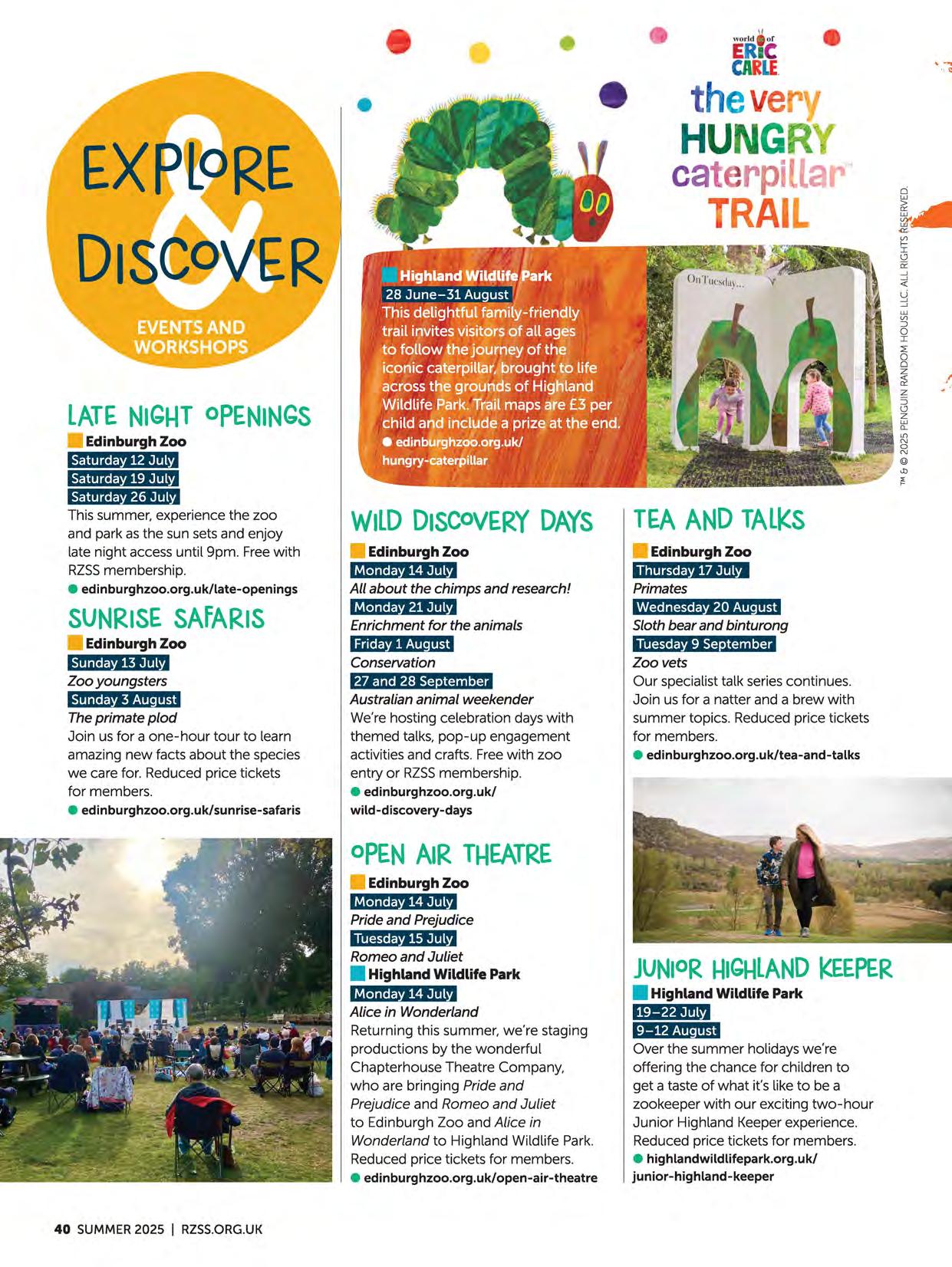
TEAANDTALKS
Edinburgh Zoo
Thursday 17 July
Primates
Wednesda 20 Au ust
Slothbear and binturong
Tuesday 9 September
Zoo vets
Our specialist talk series continues. Join us for a natter and a brew with summer topics. Reduced price tickets for members.
• edinburghzoo.org.uk/tea-and-talks
JUN1°R1-UGI-ILANDKEEPER
Highland Wildlife Park 1€etit4ffld Dtl411t•W
Over the summer holidays we're offering the chance for children to get a taste of what it's like to be a zookeeper with our exciting two-hour Junior Highland Keeper experience. Reduced price tickets for members.
• highlandwildlifepark.org.uk/ junior-highland-keeper
28 July-1 August
4 August-a August
This week-long programme for 16-18-year-olds offers an introduction to zoo management and the chance to interact with RZSSspecialists.
edinburghzoo.org.uk/ events-experiences/events/ science-summer-school
NATURE. PI-IOTOGRAPI-IY
W0 RKSl-l 0 P
Edinburgh Zoo
20 and 21 August
1 and 2 September
Highland Wildlife Park
25 and 26 September
Our much-loved full-day photography workshops are back for 2025. Reduced price tickets for members.
• edinburghzoo.org.uk/ nature-photography-workshops
• highlandwildlifepark.org.uk/ nature-photography-workshops

6 and 7 August
Our three-hour Summer Explorer sessions are a great opportunity to introduce your children to the wonderful world of wildlife at Edinburgh Zoo! edinburghzoo.org.uk/ summer-explorers
Highland Wildlife Park
28 July-1 August
Following the success of our Science Summer School and Summer Explorers programmes, we are delighted to introduce a Highland Wildlife Park Summer Club for 2025! Each day has its own theme, including wildlife wonders, junior scientists, creative critters and fun in the sun. edinburghzoo.org.uk/ summer-club
CRE.E.PCALM
W0 RKSl-l 0 Ps
Edinburgh Zoo
Sunday 7 September
Sunday 14 September
Sunday 21 September
Sunday 28 September
Highland Wildlife Park
Sunday 5 October
JUN1°RNATURE.
P1-1°T 0
GRAPI-IY
W0 RKSl-l 0 P
Edinburgh Zoo
Sunday 31 August
We're here to help budding young nature photographers hone their skills. This half-day workshop is for participants aged 11-15. Reduced price tickets for members.
• edinburghzoo.org.uk/ junior-nature-photography
Don't be caught out this autumnthere's still space! Back to help fight your fear, our expert team are on hand to help you tackle your spider phobia. Reduced price tickets for members.
• edinburghzoo.org.uk/creep-calm-workshops
z
PAWPATR 0 U
Edinburgh Zoo
Saturday 13 September
Paw Patrol pups Chase and Skye will be taking a break from Adventure Bay to visit Edinburgh Zoo. Free with zoo entry or RZSSmembership.
• edinburghzoo.org.uk/ paw-patrol

Edinburgh Zoo
Looking to plan an awesome experience for your little one's birthday? We have two koala-ty children's birthday party packages to choose from. Both include an interactive tour with one of our friendly discovery rangers, craft activity and an exclusive lunch.
• Cheeky Monkeys Package (ages 3+)
• Paw-some Party Package (ages 5+) Head online to plan your party. edinburghzoo.org.uk/birthday-parties
PUPSANDPANCAKES
Edinburgh Zoo
Saturday 13 September
Enjoy a delicious breakfast followed by fun-filled arts and crafts, as well as a guest appearance by Chase and Skye from Paw Patrol! Reduced price tickets for members.
• edinburghzoo.org.uk/ pups-and-pancakes
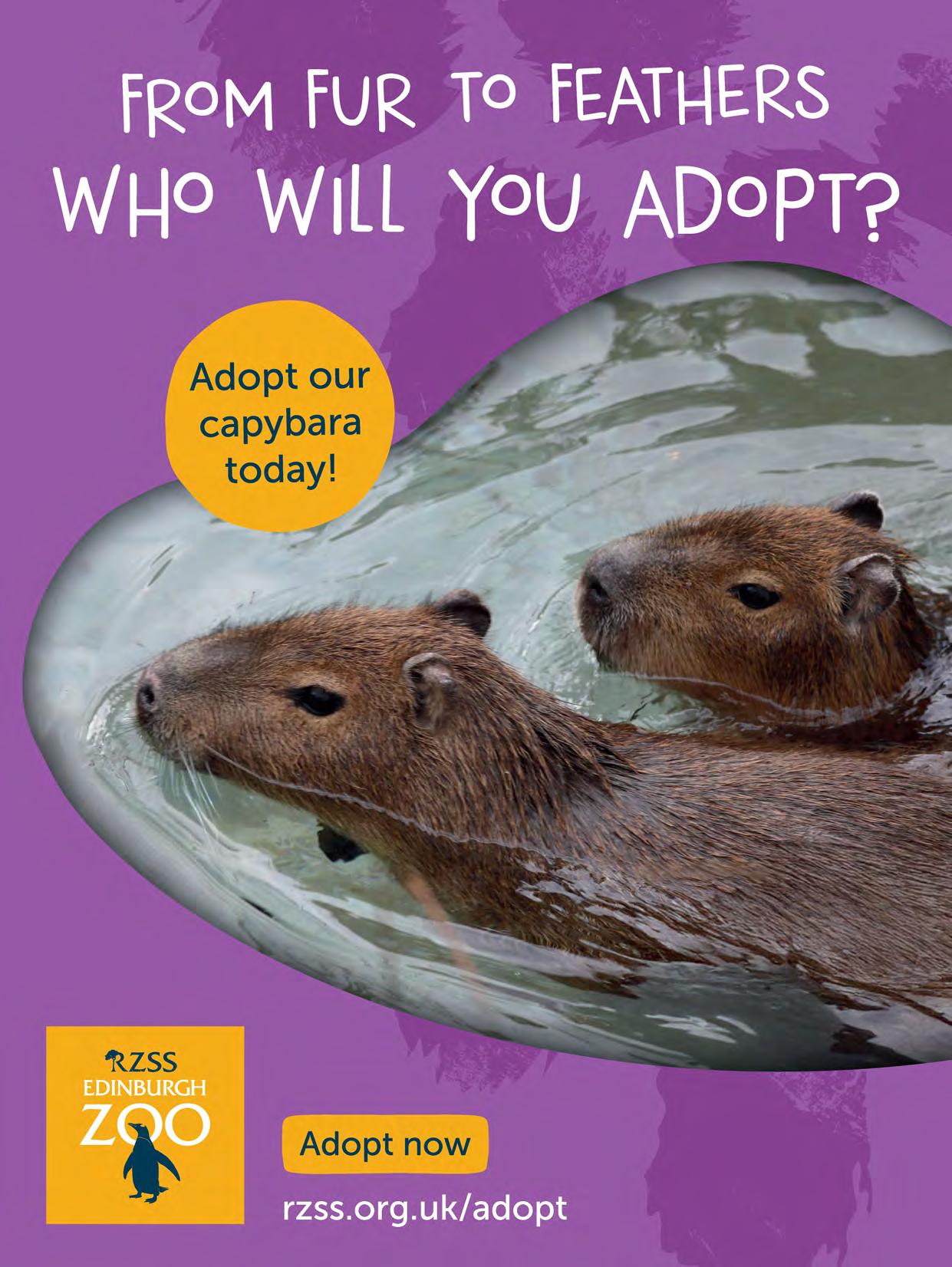
At our Edinburgh Zoo shop and online, you'll find our Hole In My Pocket range. Take a look at some highlights from the collection

P!;NGUIN ~DINBURGM zoO
Edinburgh Zoo cheetah and penguin mugs
£14each
These fun additions to your home or office celebrate two of the zoo's most loved inhabitants -our penguins and Billy the cheetah. Each mug has a graphic of one of the animals and their initial letter.
Edinburgh Zoo cheetah and penguin tea towels
£15each
Whether you're soaking up a splash or want to add a spot of colour to your kitchen, these tea towels are a great way to add some animal decor. Sold separately, their repeating pattern is eye-catching and vibrant.
Highland Wildlife Park multi-animal range
£12 mug and £9.50 notebook
Our new Highland Wildlife Park range celebrates the many animals you'll see on your visit, including grey wolves, snow leopards, wildcats and Arctic foxes. It includes an AS notebook with lined pages and a ceramic mug, among others.
Highland Wildlife Park multi-animal water bottle
£13
You can also pick up a new water bottle that showcases Highland Wildlife Park's residents. It's a perfect way to cut down on plastic waste while supporting your favourite animals.
shop.rzss.org.uk

We are delighted to partner with Allistair J Burt from Hole In My Pocket for a range of fun, quirky products that celebrate some of the animals at Edinburgh Zoo.
·working with the zoo team has been great. they are so enthusiastic and knowledgeable about what they do," Allistair says. "Collaborating on designs was tonnes of fun and between us we actually ended up with way more ideas than we could use. Hopefully that means we'll be able to expand the collection with more animals in the future.
"The absolute best thing about working on the range was definitely getting to spend the day in the zoo doing research. It was such a lovely scorching morning when I arrived and I had a brilliant and full day. The sunshine seemed to really bring the animals out and someone had clearly been giving them great modelling instructions to pose for me to do sketches."
For Allistair, the zoo holds old memories, too.
·one of my earliest memories of the zoo is from when I was a child and my sister did fund raising towards the care cost of a snow leopard. There was a wee sign on the enclosure with her name on it and I remember us going through to visit and seeing the leopard. It felt like a giant mythic creature to me as a child."
Allistair worked alongside our team at Edinburgh Zoo to decide on the best approach.
·we weren't quite sure what style would be best so I initially drew both penguins and cheetahs in three different styles. First in a geometric digital version and then a more scribbly and cartoon-like colour pencil version and finally the retromodern style that we eventually went with.
"I'm delighted with how the collection turned out and it looks great the way the team have merchandised it all in store."
hen you visit Edinburgh Zoo or Highland Wildlife Park, you may be surprised to learn that much of what you see has been made possible through a gift in a Will.
A gift to the capybaras
Did you know a kind gift from a member of RZSSin 2024 helped build a special habitat for Edinburgh Zoo's new capybaras? The delightful Cali, Luna and Rodney arrived earlier this year. They have been enjoying exploring their new home which mimics their natural environment with plenty of water, grass and places to hide. The trio particularly love swimming in their outdoor pool. Thanks to this member leaving RZSSa gift in their Will, thousands of visitors to the zoo can now enjoy watching and learning more about these charming animals. We hope that soon there will be babybaras running around!
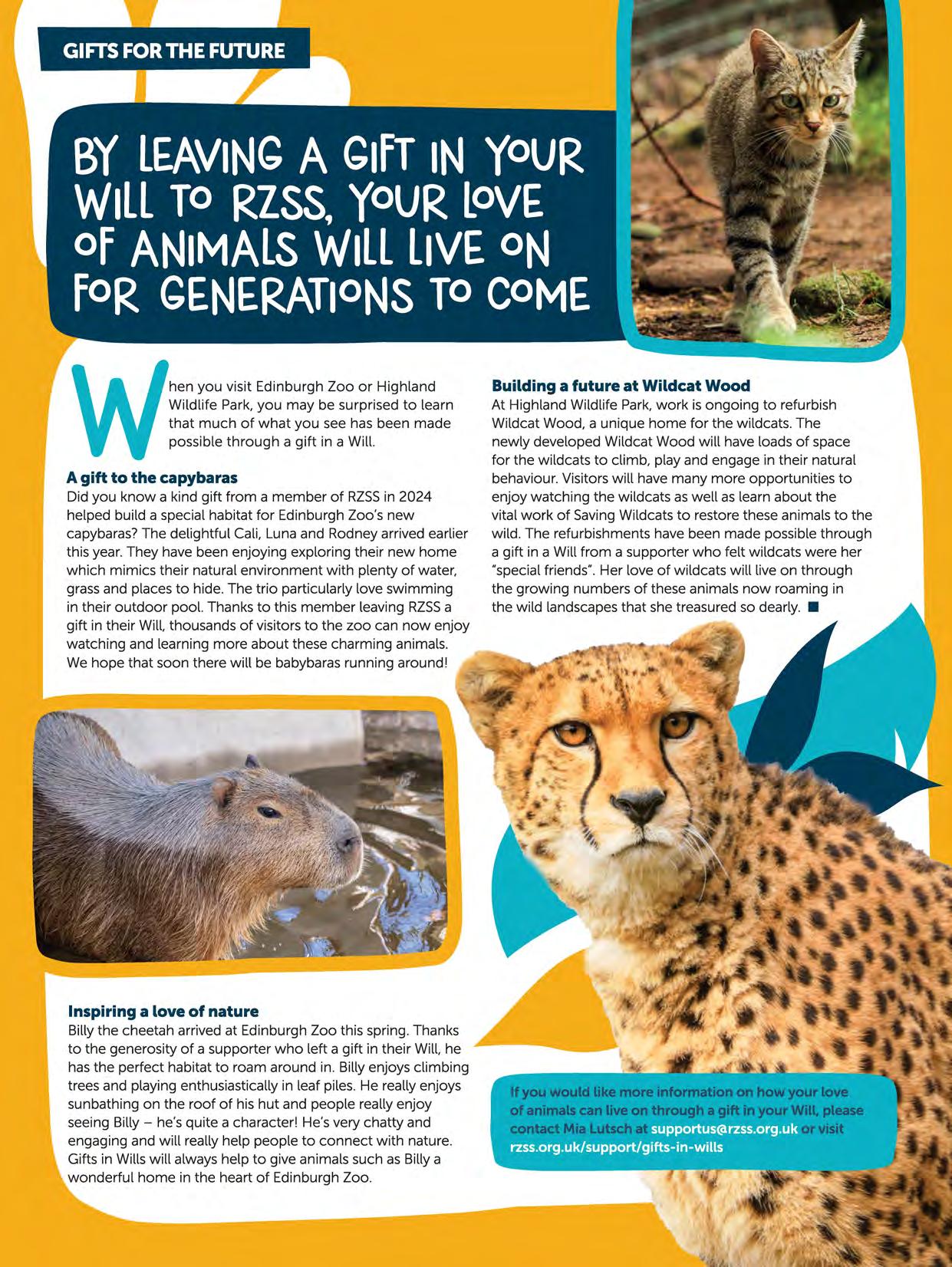
Inspiring a love of nature
Billy the cheetah arrived at Edinburgh Zoo this spring. Thanks to the generosity of a supporter who left a gift in their Will, he has the perfect habitat to roam around in. Billy enjoys climbing trees and playing enthusiastically in leaf piles. He really enjoys sunbathing on the roof of his hut and people really enjoy seeing Billy -he's quite a character! He's very chatty and engaging and will really help people to connect with nature. Gifts in Wills will always help to give animals such as Billy a wonderful home in the heart of Edinburgh Zoo.
Building a future at Wildcat Wood
At Highland Wildlife Park, work is ongoing to refurbish Wildcat Wood, a unique home for the wildcats. The newly developed Wildcat Wood will have loads of space for the wildcats to climb, play and engage in their natural behaviour. Visitors will have many more opportunities to enjoy watching the wildcats as well as learn about the vital work of Saving Wildcats to restore these animals to the wild. The refurbishments have been made possible through a gift in a Will from a supporter who felt wildcats were her "special friends". Her love of wildcats will live on through the growing numbers of these animals now roaming in the wild landscapes that she treasured so dearly.
If ofa co
Wonderful willow used across Edinburgh Zoo: for food, shelter and more
Up to 5,000 willow plants are grown on site at Edinburgh Zoo because this versatile plant is so useful, including as a source of food and for animal enrichment. The giraffes love eating the homegrown willow and will meticulously strip each stem of leaves and bark Meanwhile, long coppiced willow rods are used to build rustic fences in the warty pigs' enclosure and to create a separation fence between the wallabies. Gardener Robbie has also become an expert at weaving together the willow to create beautiful conical 'nests' which act as both bird hides and shelters for small primates. You can find some with the ring-tailed lemurs. Why not do something similar in your own garden? Leafy wigwams and living fences are easy to create by simply pushing willow whips into the ground in the early summer months and then tying into the desired shape. Using gentle pressure should prevent the willow snapping.
Growing ambition in the Cairngorms
With increasing restrictions on plant : movement to reduce the spread of
pests and disease, the gardening team
plan to propagate more plants on site at
Highland WildlifePark in future, rather
than growing them in Edinburgh and
transporting them north. Recently, a small
team of volunteershelped to restorean
old polytunnel at the park and as plants
come into growth over the summer, the
gardening team will be taking lots of
cuttings of important native plants such
as heather, bilberry and juniper.

Platefuls of petals
Did you know that clover flowers taste like liquorice? Together, the gardening team and Edinburgh Zoo's head chef have been experimenting with the edible potential of some easy-to-grow garden flowers. And it's something you can do at home, too. The petals of dianthus and carnation will add a clove-like flavour to desserts, while the flowers of nasturtium, radish and chives add a tang to salads. Rose petals and lavender flowers can be crystallised and used to flavour drinks or decorate cakes, or try dipping the flowers from squash plants in a light batter and deep-fry like tempura. And if you're short of salad leaves? Try dandelion leaves for a flavour similar to endive or radicchio.
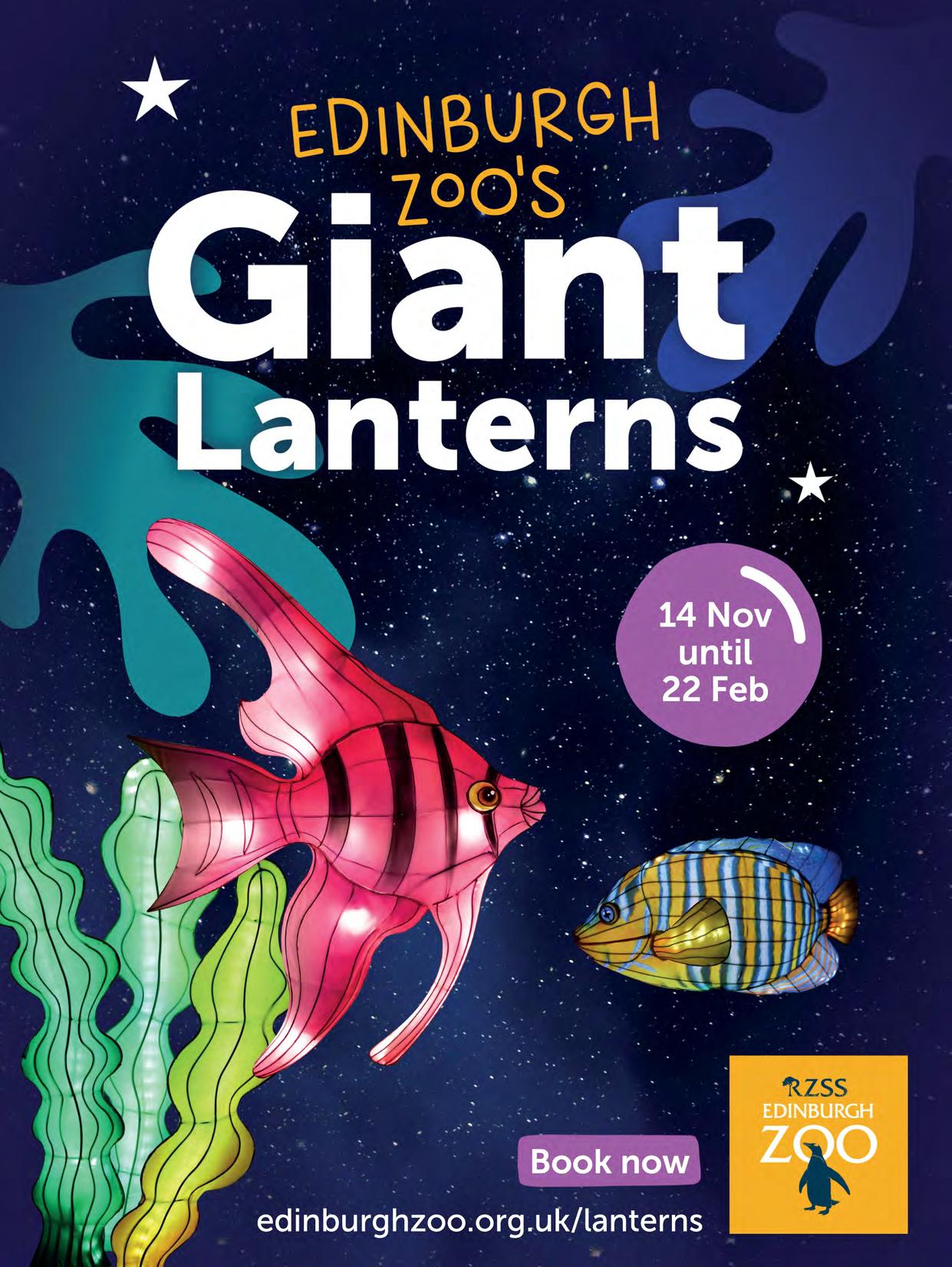
THE ANSWERS TO THE CLUES I C BY CLOSELY READING THIS ~L.M'"T" • THEN, CAN FIND YOUR WAY TH Y MAZE.
SUMMER

Down
1. What is the name of the wolverine we included in 'Day in the Life'? (4)
2. What is the name of the male capybara at Edinburgh Zoo? (6)
6. What is the name of our young pygmy hippo, who also happens to be a social media sensation? (6)
Across
3. What bendy plant is used to make rustic fences, nests and
4. What is the name of the Ugandan Forest where RZSS has supported chimpanzee conservation for 20 years? (7) even snacks for giraffes? (6) 6
5. What is the world's fastest land
5. What is a word for both a home on wheels and a group of Bactrian camels? OJ animal over short distances? OJ
7. Zeferino and Gizmo are both giant ____ ? (9)
Can you help our lost gentoo find a path to feeding time?
When talking to Maurice Hickman about his favourite memories from the four and a half years he's worked with RZSS,the answers are as varied as you might expect.
Maurice gets to spend time up close with lots of different animals, conducting walks, talks and tours. One of his most memorable encounters involves Tayo, Edinburgh Zoo's male drill monkey, who was celebrating his birthday.
"At the birthday party was a drill-safe cake, which was made of beetroot and had candles cut out of vegetables, presents that had been wrapped and a banner that said, 'Have a roar-some day'," Maurice explains. "Oh, and a paddling pool with edible, monkey-safe bubbles, which he was obsessed with. I just thought. 'Oh my gosh, this is honestly incredible'."
Spending as much time as he does with the zoo's residents means it's not all birthday cakes and paddling pools, though.
"I don't want to be known as the zoo poo man," Maurice says, "although unfortunately I was very much a big champion of it all when we did the
1~t the birthday party was a drill-safe cake1 which was made of beetroot and had candles cut out of vegetables1 presents that had been wrapped and a banner that said11Have a roar-some day 11
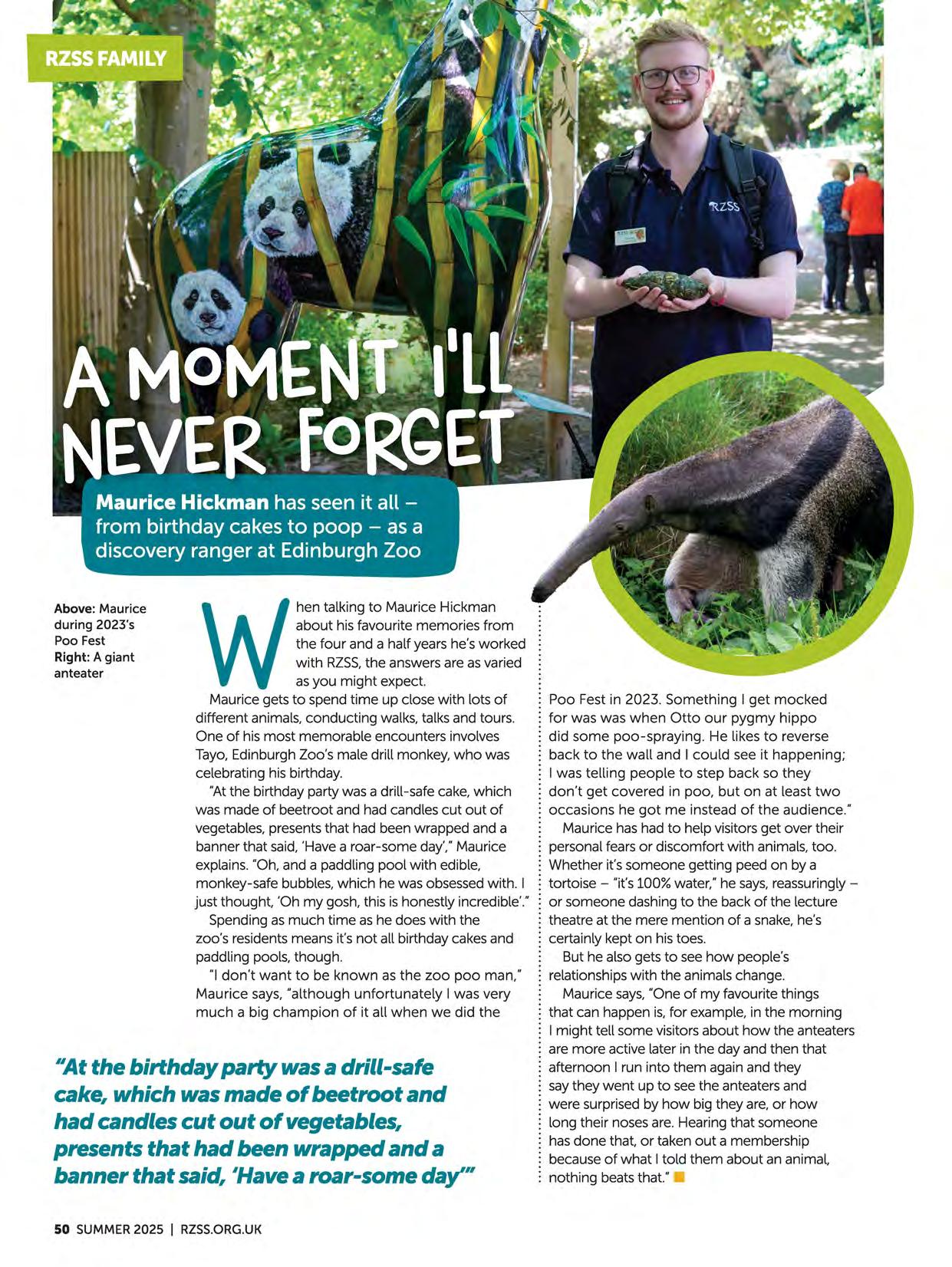
Pao Fest in 2023. Something I get mocked for was was when Otto our pygmy hippo did some poo-spraying. He likes to reverse back to the wall and I could see it happening; I was telling people to step back so they don't get covered in poo, but on at least two occasions he got me instead of the audience."
Maurice has had to help visitors get over their personal fears or discomfort with animals, too. Whether it's someone getting peed on by a tortoise - "it's 100% water," he says, reassuringlyor someone dashing to the back of the lecture theatre at the mere mention of a snake, he's certainly kept on his toes.
But he also gets to see how people's relationships with the animals change.
Maurice says, "One of my favourite things that can happen is, for example, in the morning I might tell some visitors about how the anteaters are more active later in the day and then that afternoon I run into them again and they say they went up to see the anteaters and were surprised by how big they are, or how long their noses are. Hearing that someone has done that, or taken out a membership because of what I told them about an animal, nothing beats
Above: Maurice during 2023's Poo Fest
Right: A giant anteater
Stories for Little Explorers
A colourful picture book offering a hilarious insight into a child's curious mind.
:4 wondeiful celebration of the art of asking questions. '
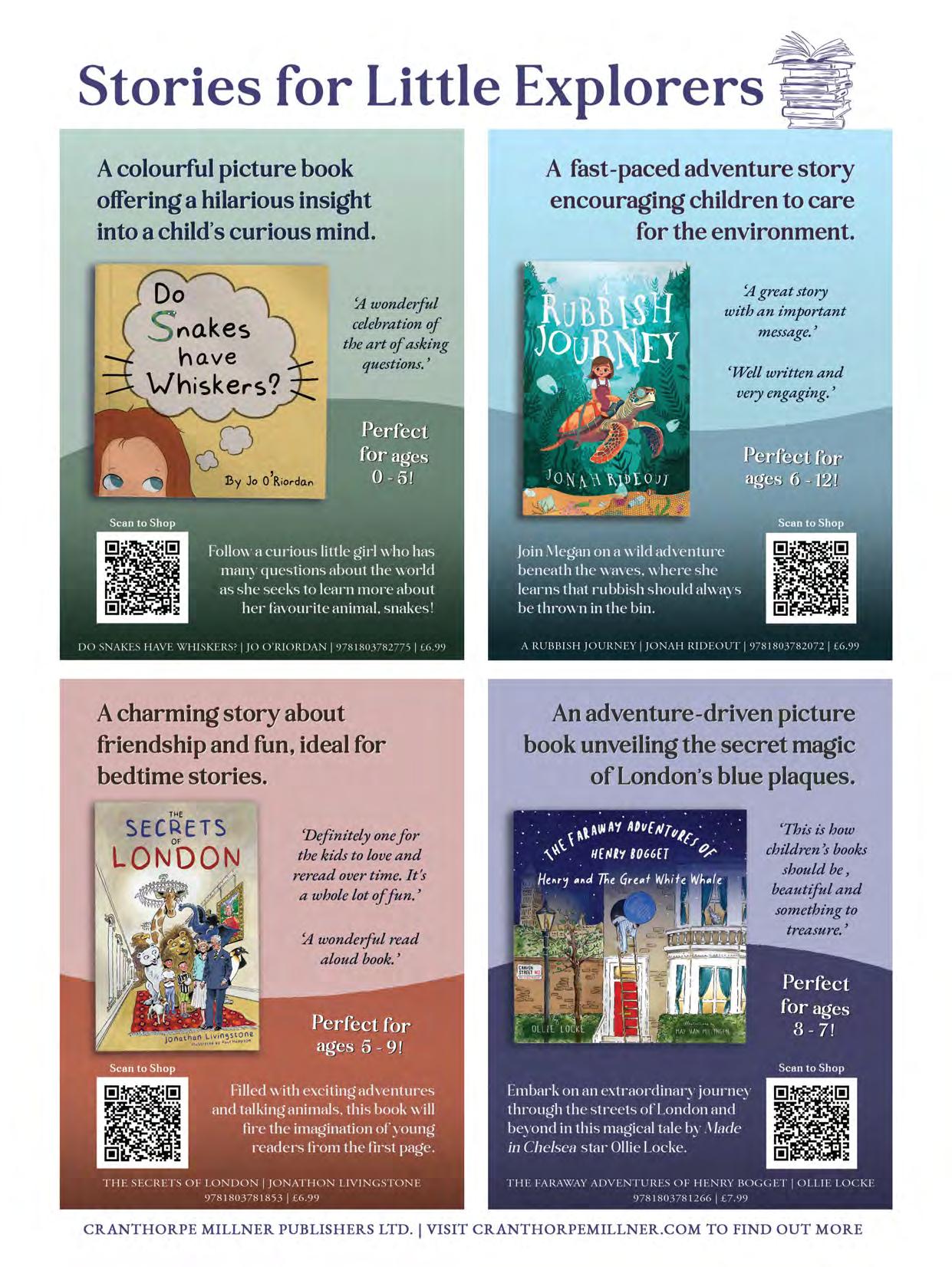
A fast-paced adventure story encouraging children to care for the environment.
:4 great story wlth an important message.'
'Well wn"tten and very engaging.'
A charming story about friendship and fun, ideal for bedtime stories. THE SECRETS LON°DON ,1
'Deflnltely onefor the klds to love and reread over time. It's a whole lot of fun.'
:4 wondeiful read aloud book.'
An adventure-driven picture book unveiling the secret magic of London's blue plaques.
'This ls how children~ books should be, beautiful and something to

